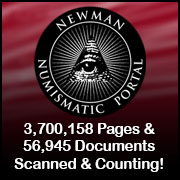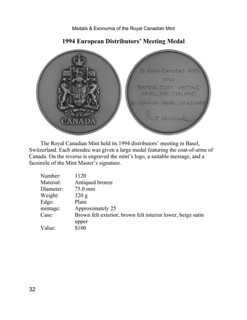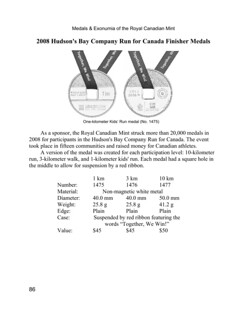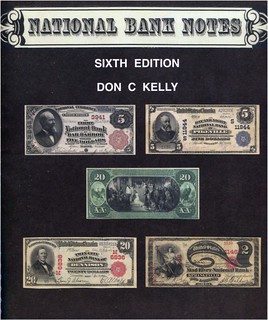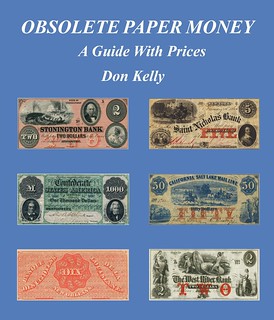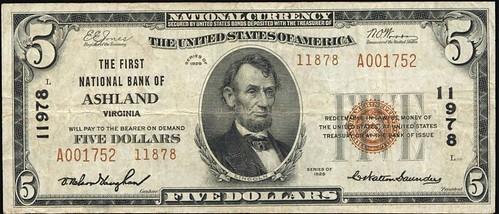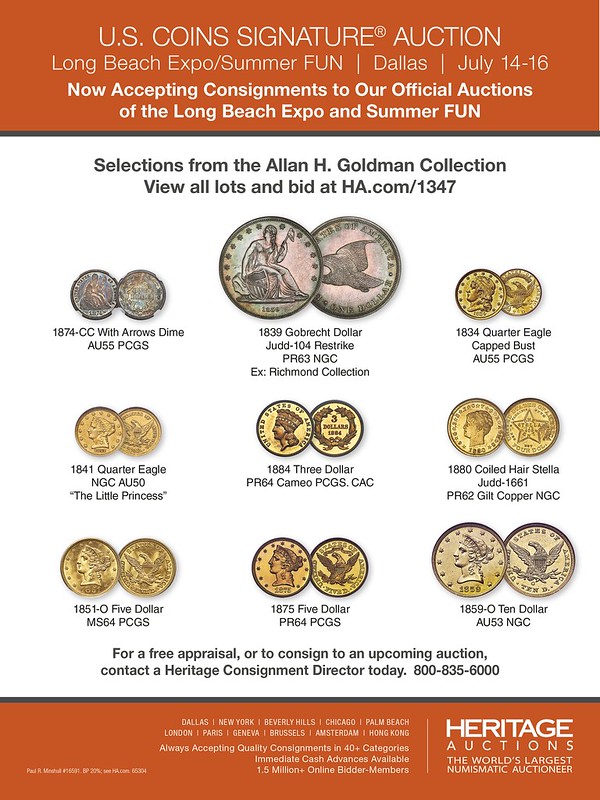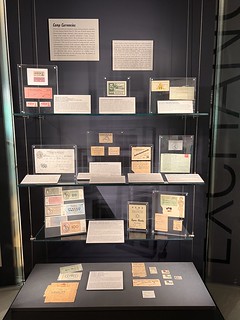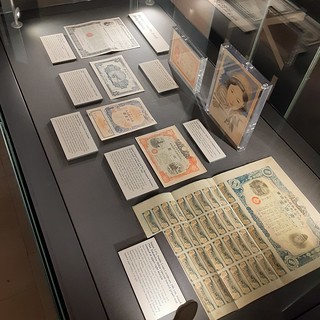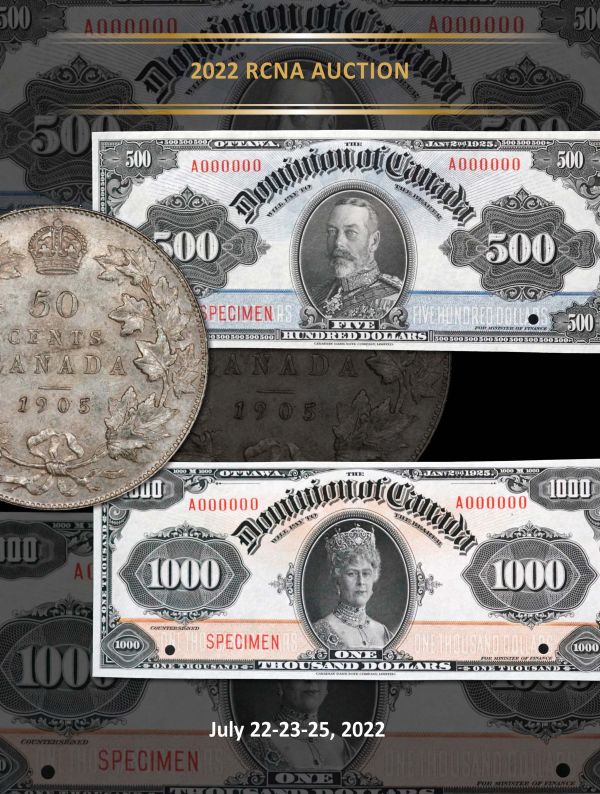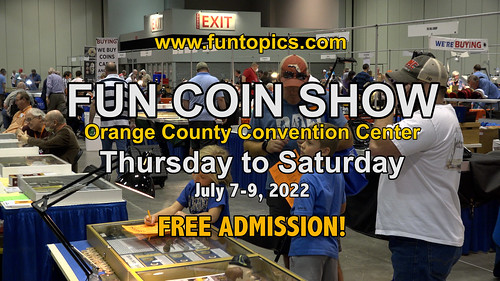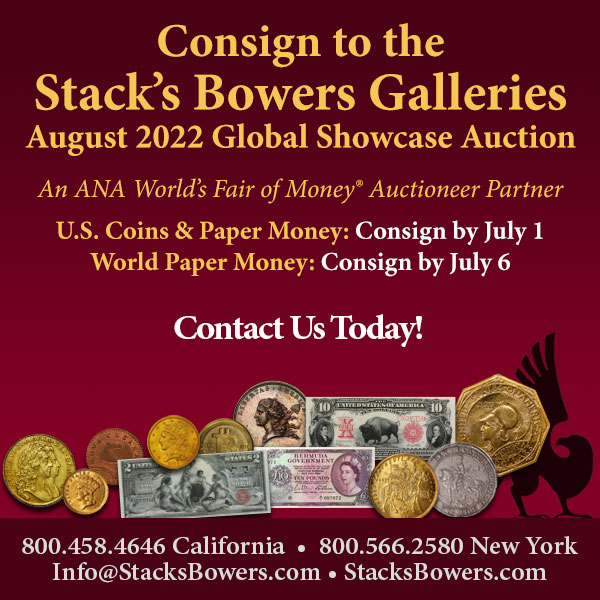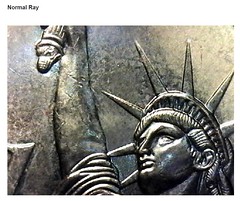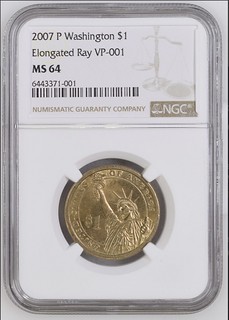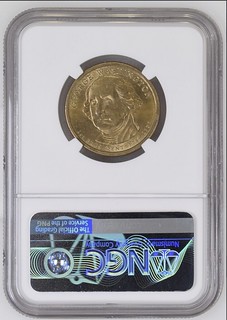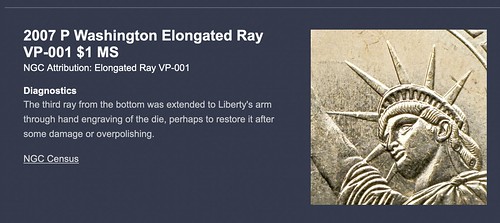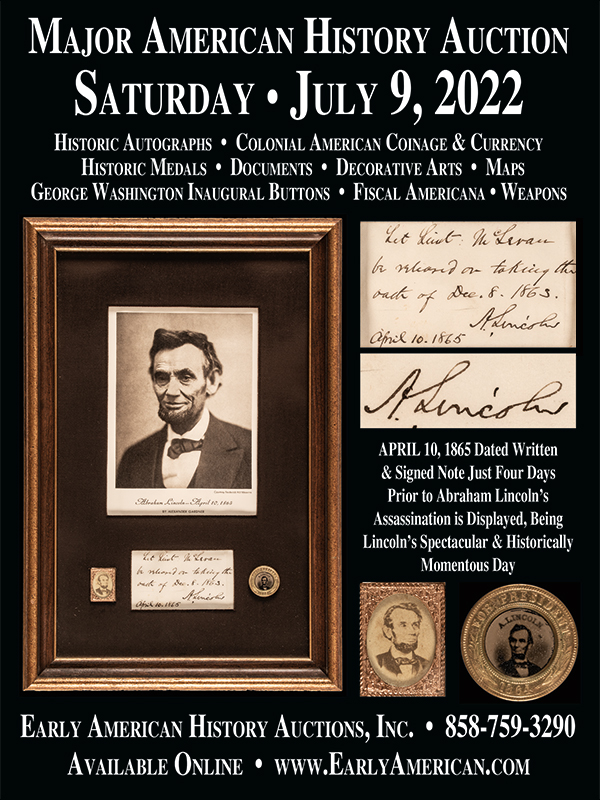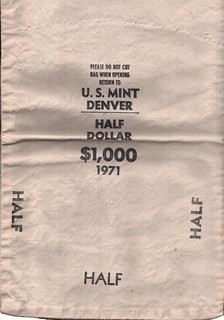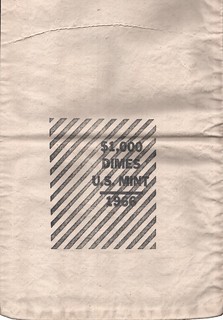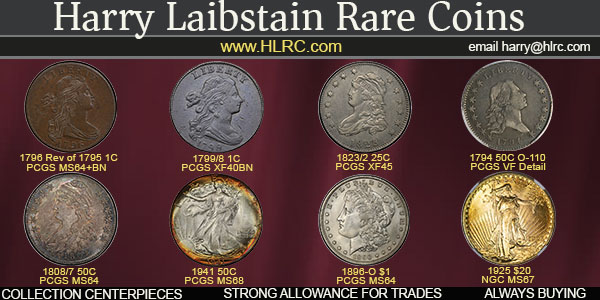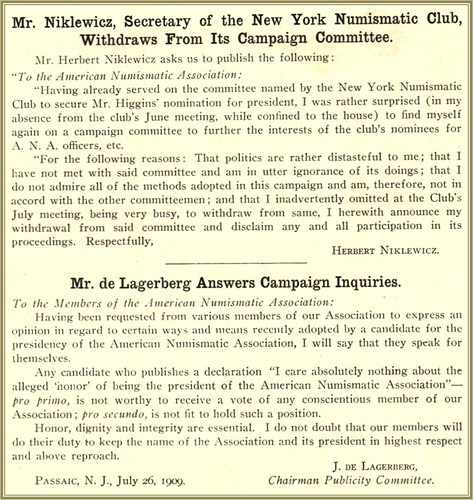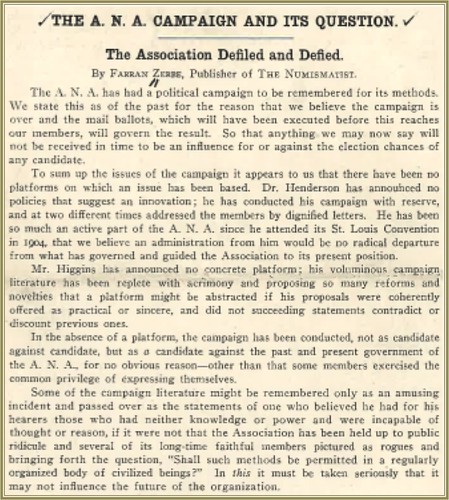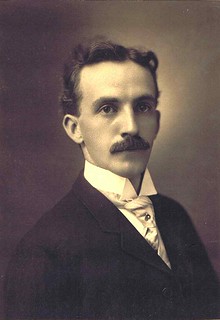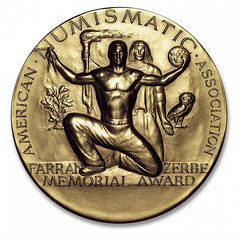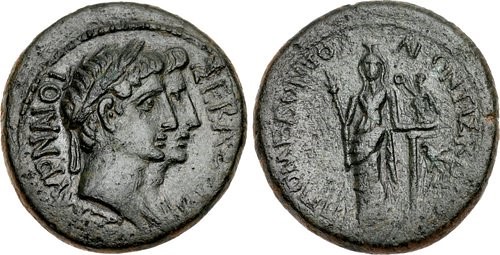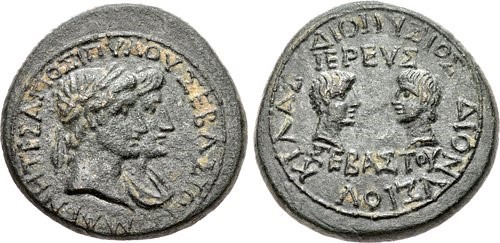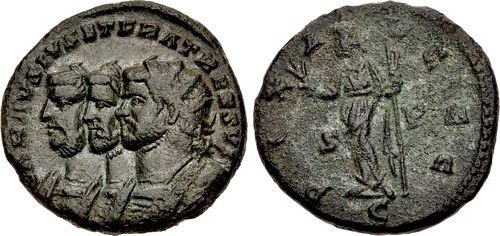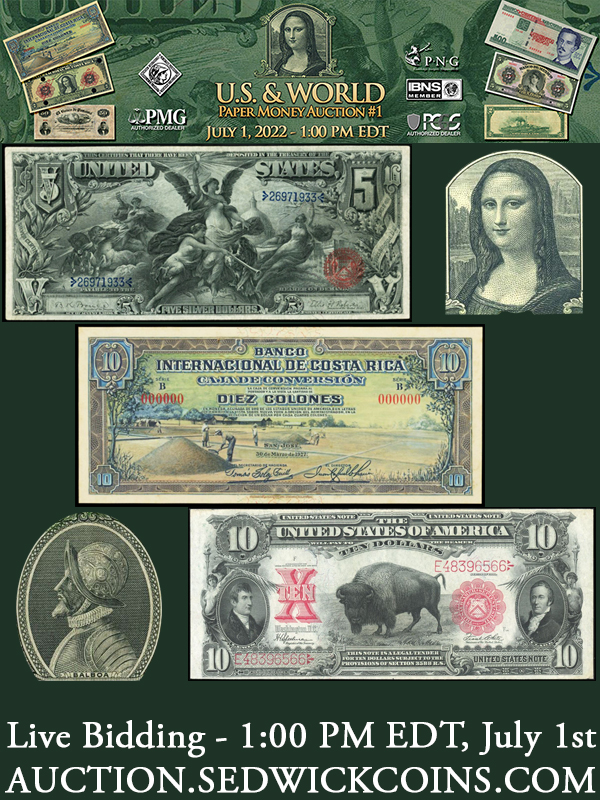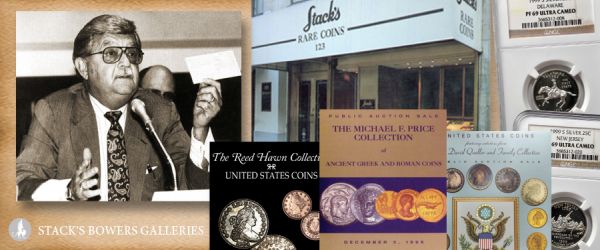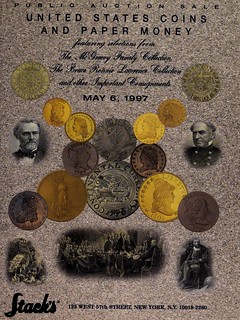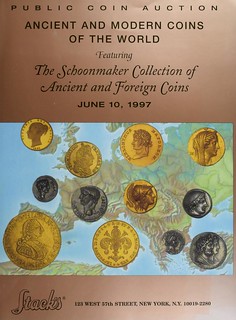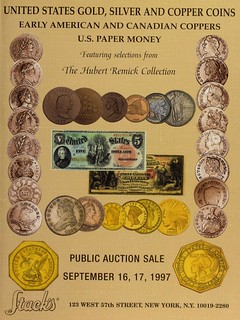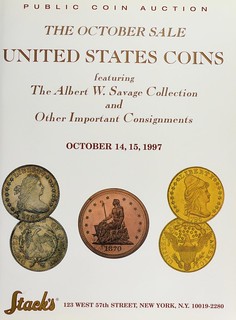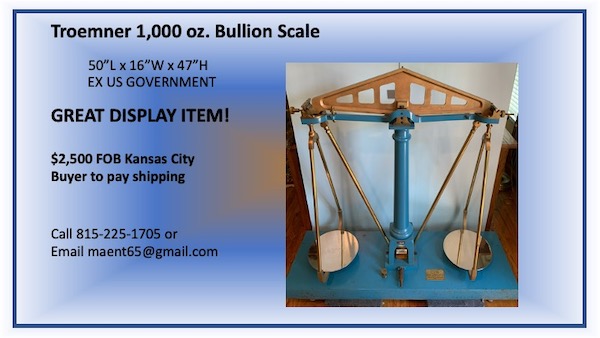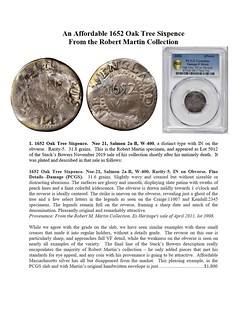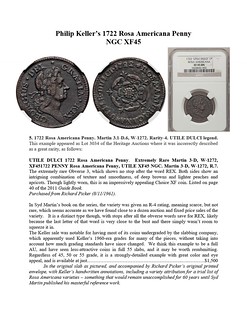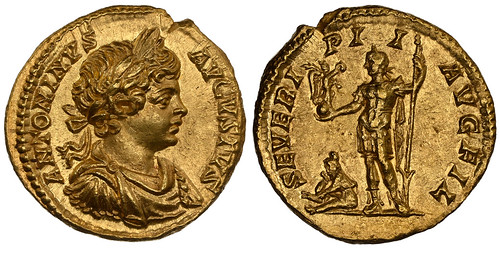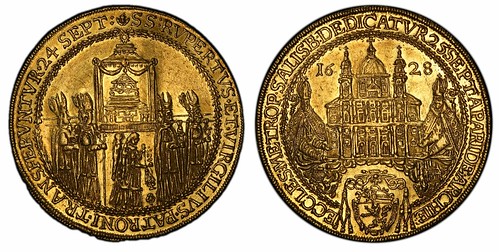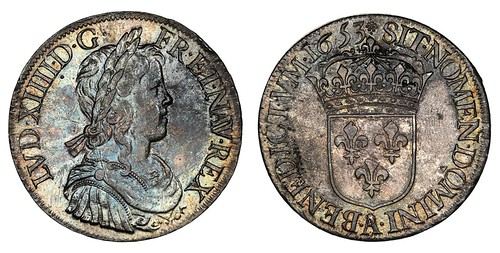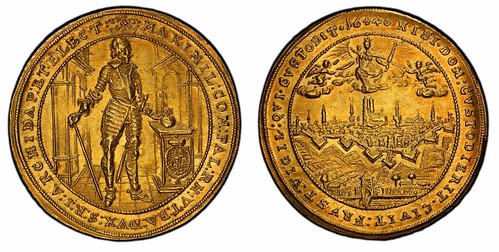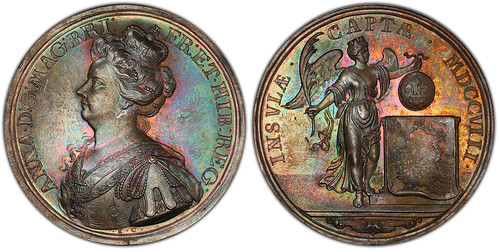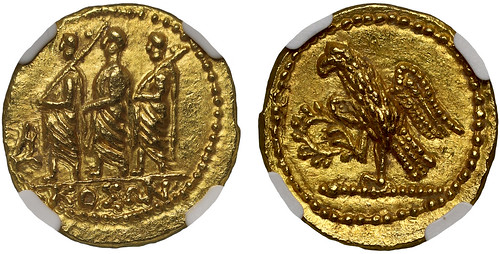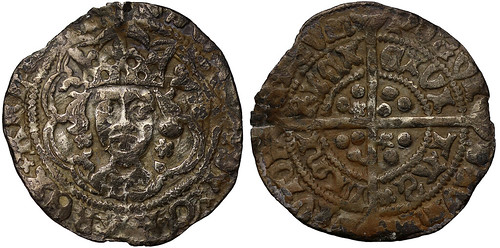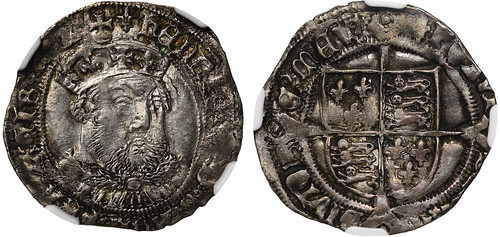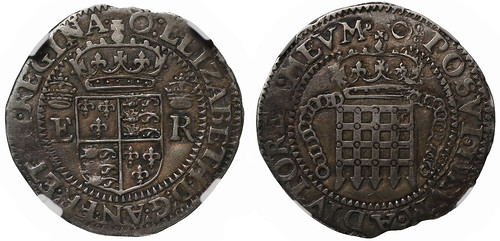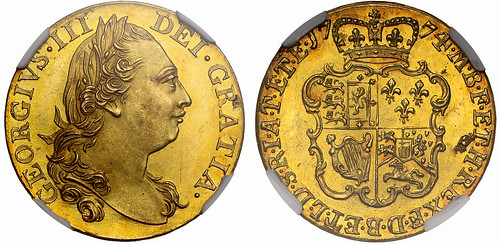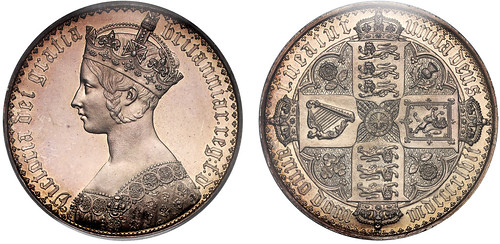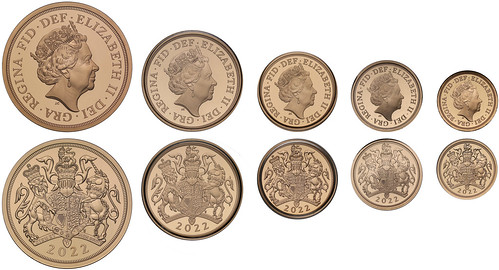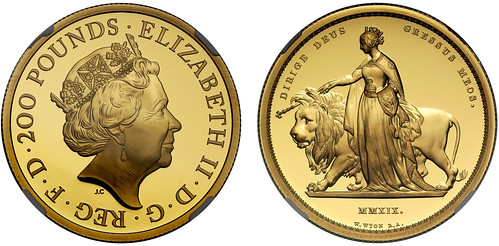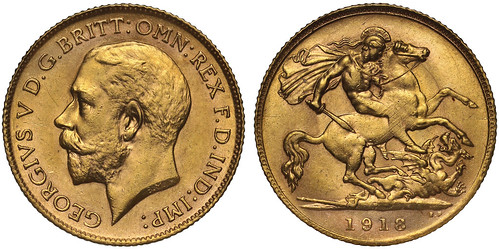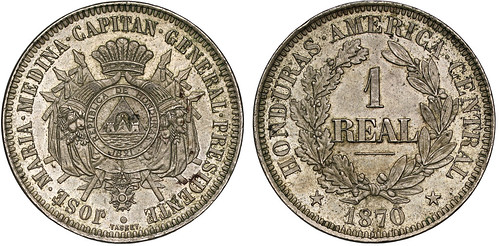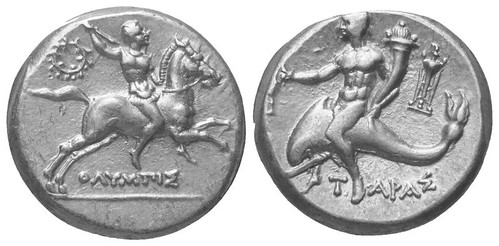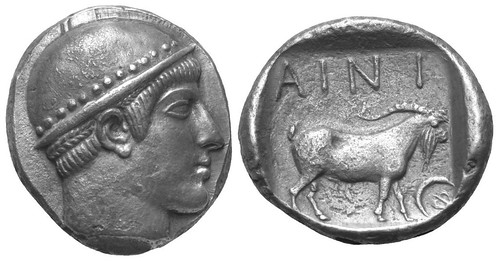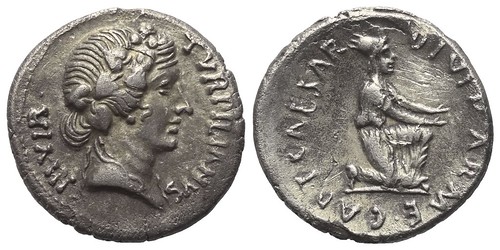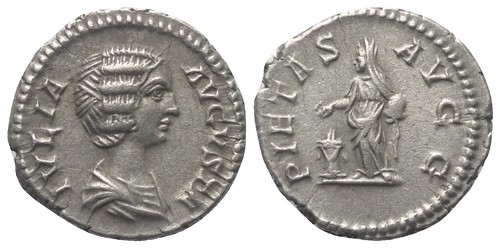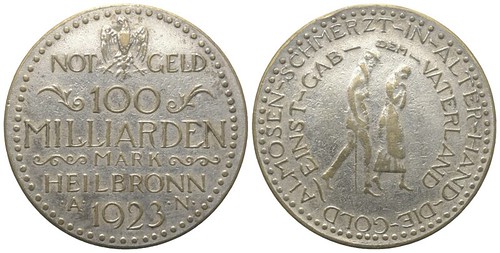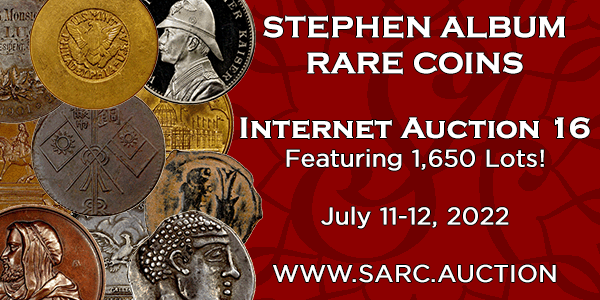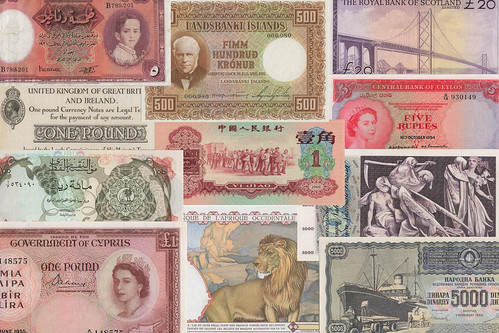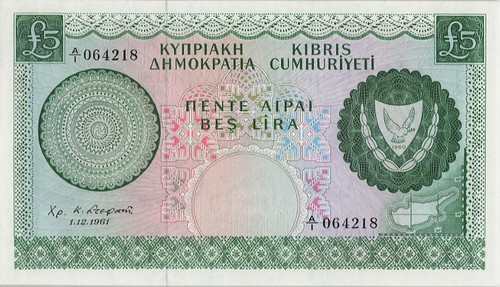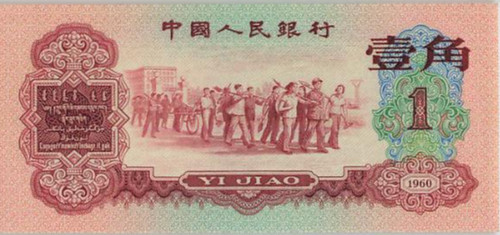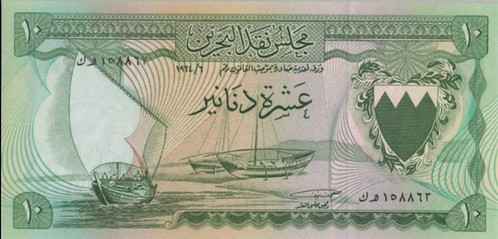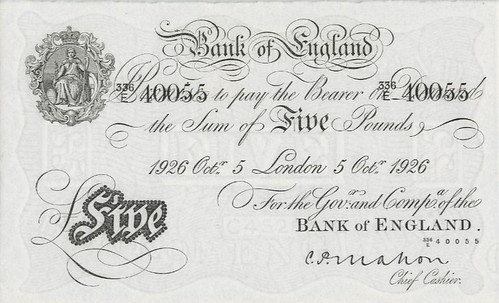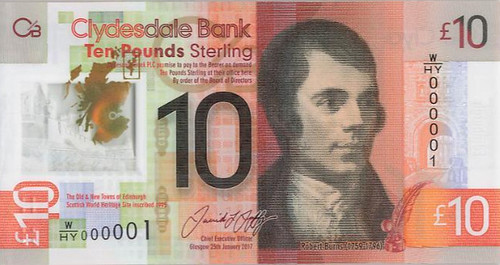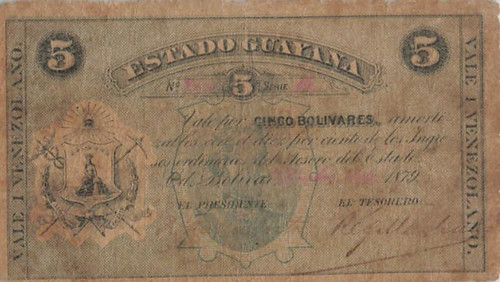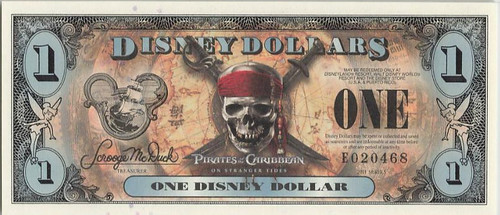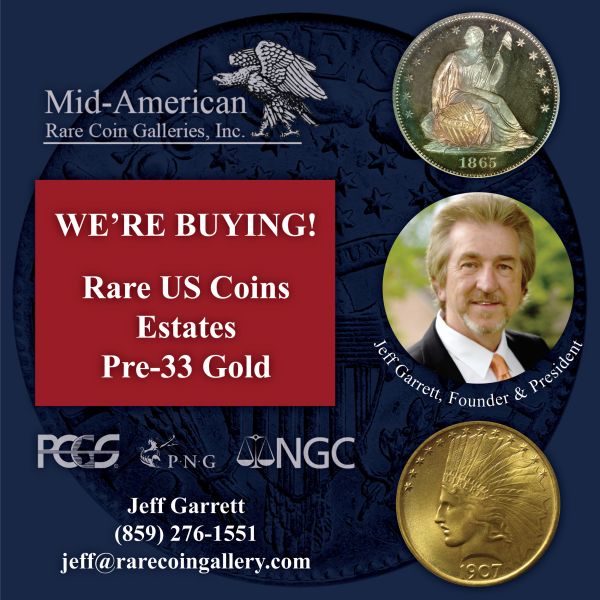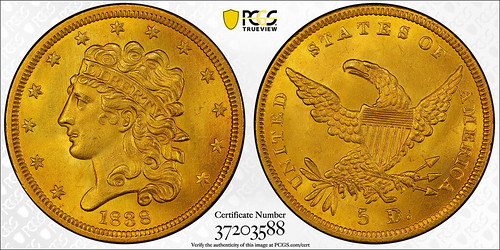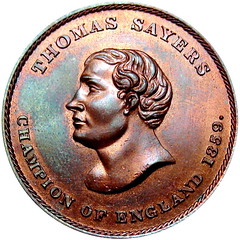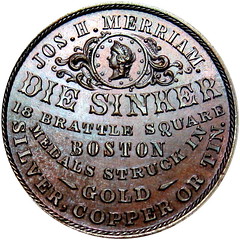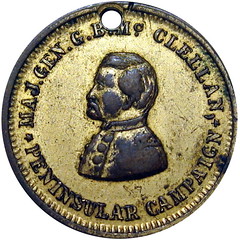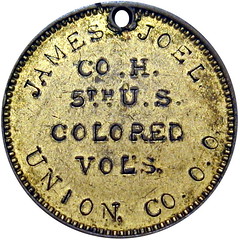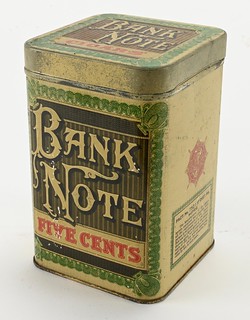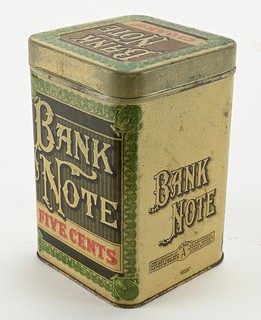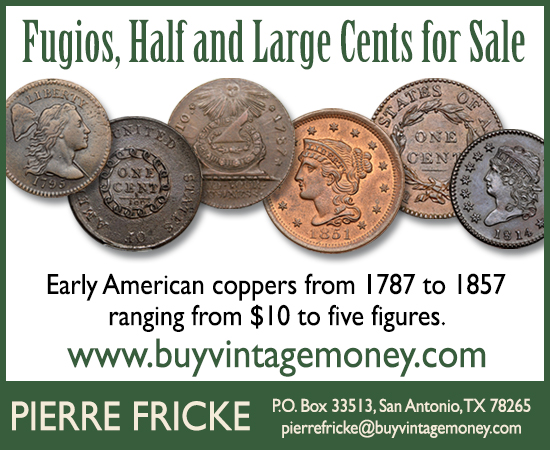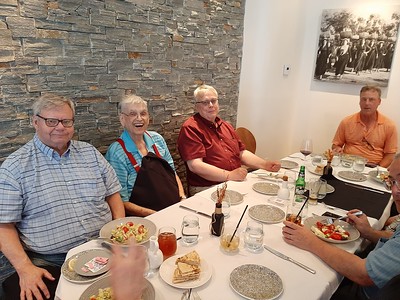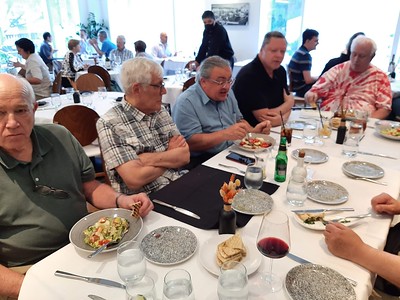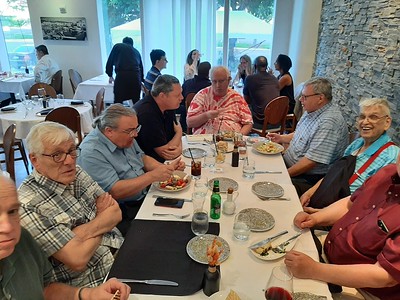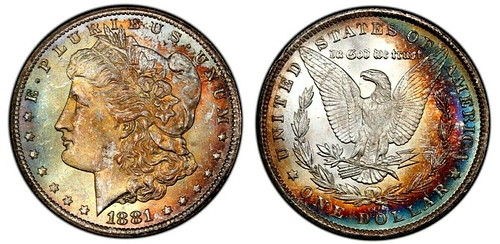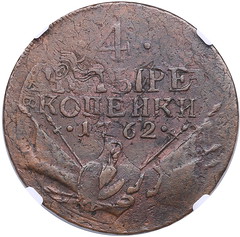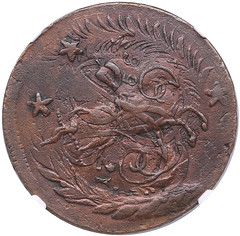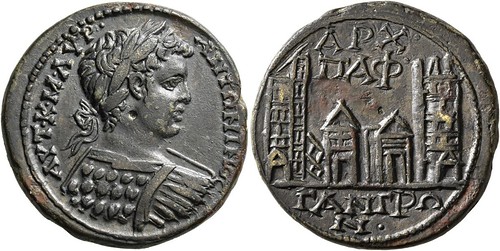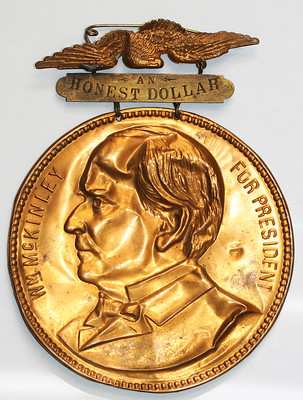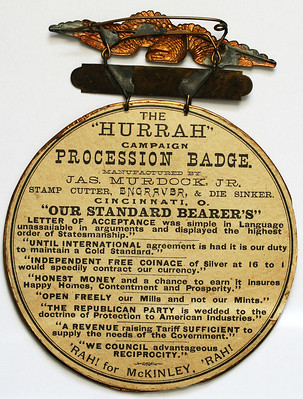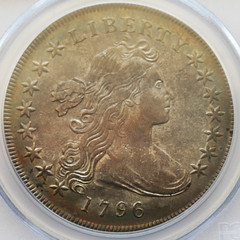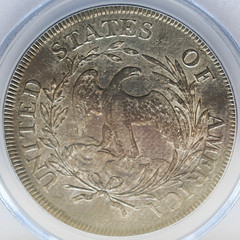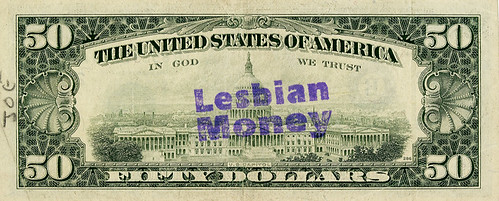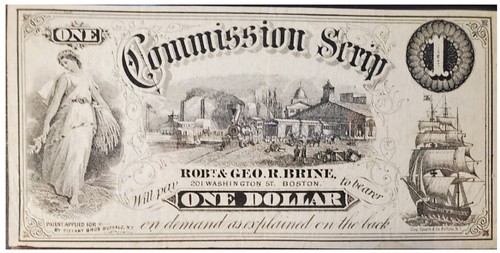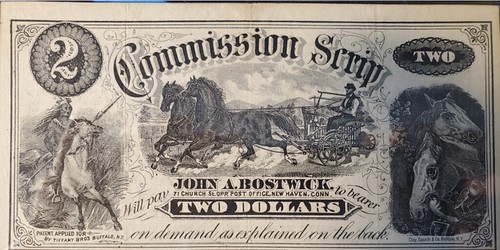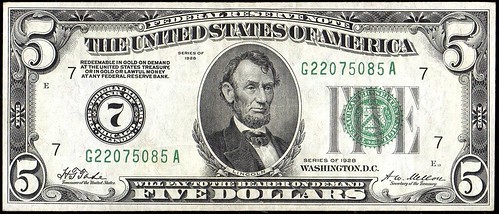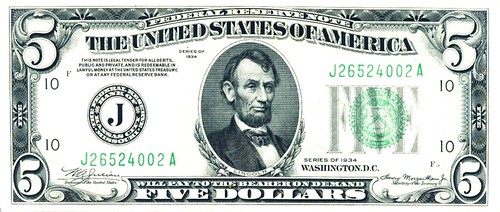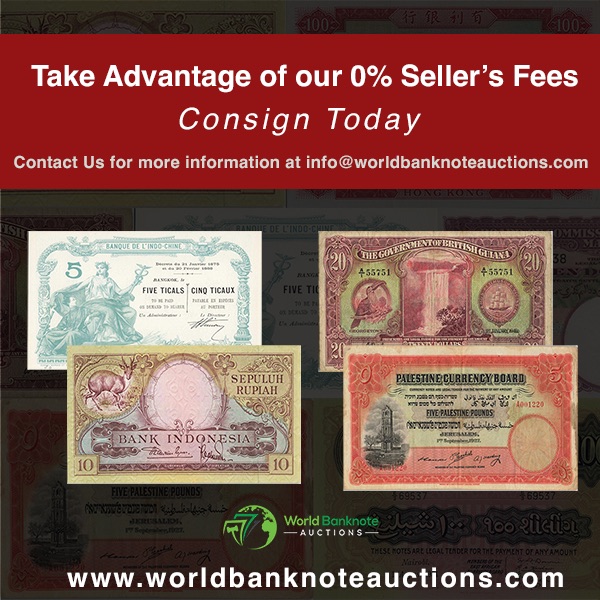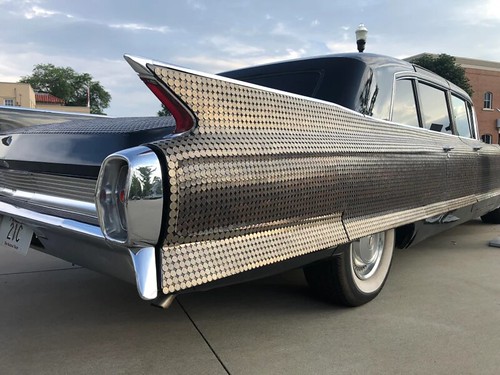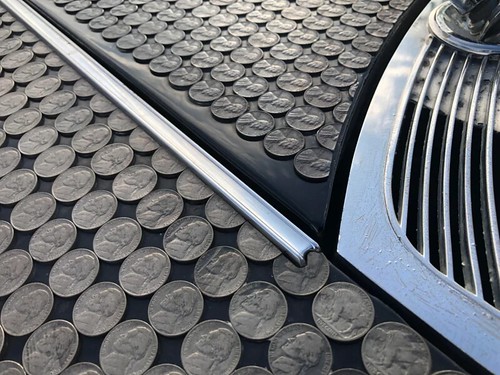
Visit our NBS Sponsors



About UsThe Numismatic Bibliomania Society is a non-profit association devoted to the study and enjoyment of numismatic literature. For more information please see our web site at coinbooks.org SubscriptionsThose wishing to become new E-Sylum subscribers (or wishing to Unsubscribe) can go to the following web page link MembershipThere is a membership application available on the web site Membership Application To join, print the application and return it with your check to the address printed on the application. Print/Digital membership is $40 to addresses in the U.S., and $60 elsewhere. A digital-only membership is available for $25. For those without web access, write to: Charles Heck, Treasurer AsylumFor Asylum mailing address changes and other membership questions, contact Chuck at this email address: treasurer@coinbooks.org SubmissionsTo submit items for publication in The E-Sylum, write to the Editor at this address: whomren@gmail.com BUY THE BOOK BEFORE THE COINSale CalendarWatch here for updates! |
- WAYNE'S WORDS: THE E-SYLUM JUNE 26, 2022
- NEW BOOK: MEDALS OF THE ROYAL CANADIAN MINT
- NEW BOOK: GERMAN NOTGELD, VOLUME 10
- DONALD CLYDE KELLY (1933-2022)
- NNP DIGITIZES ANS MEMBER CORRESPONDENCE
- WASHINGTON UNIVERSITY STORIES FROM WWII
- VIDEO: 2022 SUMMER FUN SHOW COMMERCIAL
- MORE ON GARY SNOVER
- NOTES FROM E-SYLUM READERS: JUNE 26, 2022
- NORTHWEST TERRITORIAL MINT SENTENCES
- U. S. MINT CANVAS BAGS
- MORE ON ZERBE AND THE 1909 ANA ELECTION
- VOCABULARY TERM: JUGATE
- FRANK JOHN JOSEPH (1838-1895)
- HARVEY STACK'S NUMISMATIC FAMILY, PART 124
- ROSA AMERICANA COLONIAL COINS PRICE LIST #23
- ATLAS NUMISMATICS JULY 2022 SELECTIONS
- SOVEREIGN RARITIES AUCTION 6 HIGHLIGHTS
- SOLIDUS AUCTION 102 SELECTIONS
- WORLD BANKNOTE AUCTIONS SALE 28
- CLASSIC GOLD QUARTER EAGLE AND HALF EAGLES
- NUMISMATIC NUGGETS: JUNE 26, 2022
- WAYNE'S NUMISMATIC DIARY: JUNE 26, 2022
- NUMISMATIC COMMEMORATIONS OF PRIDE
- EAST INDIA COMPANY GODDESS HERA GOLD COIN
- TIFFANY COMMISSION SCRIP
- BRITAIN'S SWITCH TO POLYMER BANKNOTES
- FEDERAL RESERVE NOTE GOLD BACKING
- THE WAL-MART COIN-COVERED CADILLAC
Click here to read the thin version on the web
Click here to subscribe
Click here to access the complete archive
To comment or submit articles, reply to whomren@gmail.com
Content presented in The E-Sylum is not necessarily researched or independently fact-checked, and views expressed do not necessarily represent those of the Numismatic Bibliomania Society.
WAYNE'S WORDS: THE E-SYLUM JUNE 26, 2022
 New subscribers this week include:
James Mchugh.
Welcome aboard!
New subscribers this week include:
James Mchugh.
Welcome aboard!
Thank you for reading The E-Sylum. If you enjoy it, please send me the email addresses of friends you think may enjoy it as well and I'll send them a subscription. Contact me at whomren@gmail.com anytime regarding your subscription, or questions, comments or suggestions about our content.
This week we open with two new books, an obituary, updates from the Newman Numismatic Portal, notes from readers, and more.
Other topics this week include Royal Canadian Mint medals, Summer FUN, U.S. Mint canvas bags, Zerbe and the 1909 ANA election, fixed price and auction previews galore, numismatic commemorations of Pride, Tiffany Commission Scrip, and the coin-covered Cadillac.
To learn more about German notgeld, Don Kelly, Gary Snover, Gutzon Borglum, Ross Hansen, Joel Iskowitz, jugates, the Schoonmaker Family Collection, the 5th US Colored Troops, the "gay loonie" and "pink money", read on. Have a great week, everyone!
Wayne Homren
Editor, The E-Sylum
NEW BOOK: MEDALS OF THE ROYAL CANADIAN MINT
Alan Roy submitted this announcement of his new book on Royal Canadian Mint medals and exonumia. Thanks, and congratulations! Alan can be reached by email at alroy477@gmail.com . -Editor
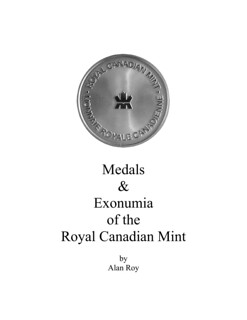 I have finally finished my passion project just in time to make it available at the Royal Canadian Numismatic Association's upcoming annual convention in Ottawa on July 20-24.
I have finally finished my passion project just in time to make it available at the Royal Canadian Numismatic Association's upcoming annual convention in Ottawa on July 20-24.
"The Medals & Exonumia of the Royal Canadian Mint" is a 138-page listing of medals issued by Canada's national mint during it's more than one hundred years of operation. It includes all known medals made and distributed by the mint. These include pieces sold directly to the public, issued in conjunction with events sponsored by the mint, and distributed at meetings or trade shows. It also includes medals issued as tokens of appreciation to employees. Another section of the catalogue lists medals featuring the Royal Canadian Mint as a theme.
The work will be privately printed and available from myself, but I will also offer copies to Richard Stockley Books (who will have a booth at the convention) for resale.
Technical information:
Card covers, spiral-bound
8.5 X 11 inches
138 pages
Printed in black and white
Tentatively priced at $12.95 CAD
NEW BOOK: GERMAN NOTGELD, VOLUME 10
Here's a Google-translated description of the announcement of a new volume on German Notgeld by Hans Ludwig Grabowski. -Editor
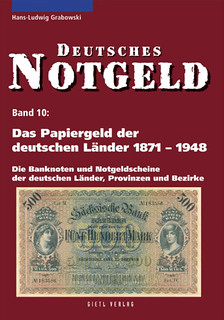 Hans Ludwig Grabowski:
Hans Ludwig Grabowski:
German Notgeld, Volume 10: The paper money of the German states 1871-1948
The banknotes and emergency money notes of the German states, provinces and districts
3rd edition 2022
approx. 750 pages, illustrated in color throughout,
Format 14.8 cm x 21 cm, paperback,
ISBN: 978-3-86646-581-7
Price: 59.80 euros
Release date: early November 2022
The special catalog, richly illustrated in full color for the first time, includes the banknotes of the private central banks, the state central banks, the state governments as well as the provincial and district administrations of the German states from the founding of the Reich in 1871 to the emergency issues after the Second World War.
The nationally valid editions of chambers of commerce and agriculture were also included.
Except for the issues of the state central banks, the vast majority of issues are state emergency money from the time of German inflation.
All editions and variants are described in detail and valued at current market prices.
Explanations of the history of the countries and provinces provide useful aids to the historical context.
The aim is to be able to show all recorded issues in color with front and back pages. To do this, new scans must be made of all notes because the first edition from 1999 is only available in black and white and the second edition from 2006 was only available in black and white.
All the notes from my own collection have already been scanned, but nobody can have all the notes and variants listed in the catalogue, not even me as the author. In addition, I have other color illustrations that were made over time.
I would appreciate if readers would support the project by providing illustrations. Collectors are welcome to email me if they would like to provide images of rare notes. When the time comes, I can publish a list of the bills for which illustrations are still missing.
The author can be reached by email at: info@geldscheine-online.com -Editor
To read the complete article, see:
Grabowski: Das Papiergeld der deutschen Länder, Neuauflage in Farbe in Vorbereitung
(https://www.geldscheine-online.com/post/grabowski-das-papiergeld-der-deutschen-l%C3%A4nder-neuauflage-in-farbe-in-vorbereitung)
THE BOOK BAZARRE
DONALD CLYDE KELLY (1933-2022)
Jerry Fochtman notified me of the passing of paper money researcher and author Don C. Kelly. Here's an excerpt from his online obituary. -Editor
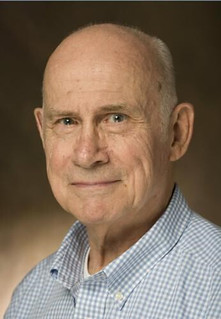 Donald Clyde Kelly was born August 18, 1933 in Poland, Ohio, the son of Pauline Gatrina Fetherolf Kelly and Leroy Clyde Kelly. He graduated from Poland Seminary High School in 1951. In 1955 Don married Jane Arlina Williams and they shared 67 wonderful years. Don loved Oxford - a great place to live, work, play, raise a family and grow old with your friends. He graduated from Miami University in 1955 and 1956 and Yale University in 1959. Don returned to Oxford in 1960 and taught at Miami for 33 years. Don is survived by his wife Jane and their four children...
Donald Clyde Kelly was born August 18, 1933 in Poland, Ohio, the son of Pauline Gatrina Fetherolf Kelly and Leroy Clyde Kelly. He graduated from Poland Seminary High School in 1951. In 1955 Don married Jane Arlina Williams and they shared 67 wonderful years. Don loved Oxford - a great place to live, work, play, raise a family and grow old with your friends. He graduated from Miami University in 1955 and 1956 and Yale University in 1959. Don returned to Oxford in 1960 and taught at Miami for 33 years. Don is survived by his wife Jane and their four children...
To read the complete obituary, see:
Donald Clyde Kelly
(https://www.legacy.com/us/obituaries/name/donald-kelly-obituary?id=35364785)
In 2015 Kelly was inducted into the Society of Paper Money's Hall of Fame. -Editor
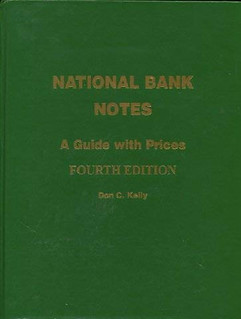 Mr. Kelly is SPMC member #1594. He was award a president's award of merit in 1998 and won multiple literary awards for articles in Paper Money. He received the Nathan Gold Memorial award in 1987. He is the author of the definitive work on national banknotes, National Banknotes; A Guide with Prices. Mr. Kelly was also awarded an ANA President's award in 2011.
Mr. Kelly is SPMC member #1594. He was award a president's award of merit in 1998 and won multiple literary awards for articles in Paper Money. He received the Nathan Gold Memorial award in 1987. He is the author of the definitive work on national banknotes, National Banknotes; A Guide with Prices. Mr. Kelly was also awarded an ANA President's award in 2011.
To read the complete article, see:
https://www.spmc.org/hall-of-fame/don-kelly
Wendell Wolka writes:
"Don was both a friend and mentor who always had time to provide information, insights, or just have a friendly conversation. I cherish our friendship and will miss Don more than he could have possibly imagined. As Don was fond of saying, Glide Free
! Glide Free Don, Glide Free."
Mike Marchioni writes:
"Great fellow and a wonderful source of information."
Peter Huntoon submitted these thoughts. -Editor
Don Kelly was a stalwart retail mail-order currency dealer for decades who agilely moved where the action was in the market. In recent years he moved aggressively into foreign currency where he found the pace and margins to be particularly attractive.
Don's major contributions to currency collecting came in the form of price guides, first his various editions of his national bank note catalog and more recently his catalog of obsolete currency. Both were major undertakings. In at least the case of his national bank catalogs, he employed his son to help with the raw typing of the endeavor.
Don was a popular and accomplished professor of physics at Miami University in Oxford, Ohio, which also was his alma mater. He capitalized on his expertise and teaching experience by authoring a best-selling undergraduate physics textbook.
He was a fit individual and an accomplished athlete who competed in discus throwing.
When he retired from his long tenure as professor, he rented a chauffeur-driven topless limo at the end of the academic year, gathered up his wife-both dressed regally-and they paraded around the campus and Oxford throwing waves like royalty to startled folks along their route. If my memory serves me correctly, there also was a bottle of champagne and toasts along the way.
Early on, he avidly collected Ohio national bank notes wherein his collection ranked among the most comprehensive being formed. The national bug bit him hard and he dug into the history of the Ohio national banks and bankers.
Being a quantitative scientist, he was one of the early compilers of national bank note census data. It was natural that when John Hickman was looking for a successor to carry on his nation-wide census before his death that he turned to Don to carry on that work. Don masterfully complied and in time during the early 2000s sold that burdensome mantle to Andrew Shiva and his National Currency Foundation where it continues to grow. That census now has well over a half million entries.
Don served as the curator at the William Higgins National Bank Note Museum for at least a couple of years before the tenure of Larry Adams began. He enjoyed his summers in Okoboji, Iowa, in that capacity because they afforded him an opportunity to work on his national bank note catalog and the census data he incorporated in it.
My dealings with Don primarily were in the realm of his census work. For years we collaborated on compiling the census data for Alaska, Arizona, New Mexico and Wyoming.
In contrast, I could count the number of notes I bought from him on one hand.
However, in the national bank note game, as in all numismatics, when a rarity comes up, the big deal is to be on the receiving end of the phone call announcing the discovery. The seller can place a good item with any number of people. I was a collector of Arizona nationals and Don had a complete listing of them with his census. Thus, he knew what I had. He chanced upon a Series of 1929 type 2 $20 from Tempe, the smallest issuer of that type in the state. It was otherwise unknown and remains so to this day. Furthermore, he noticed that it was the only type 2 from the state that I didn't have. He averred that it had to be high on my want list. Not the biggest deal in history, but I got that call. Sure, he exacted a pound of flesh in the form of a trade, but as I said, I got the call. You don't forget those.
Don was a devoted family man of the first order. His wife Jane was a wonderful and supportive spouse. He wanted his investment in his collection to benefit his children and knew it was worth far more and would net more in his hands while alive. Thus, as his children reached young adulthood and could best benefit from a financial boost to launch their lives, he knew it was time to sell. This he did, splitting the proceeds into equal shares among them, never looking back.
Don was a savvy businessman. One incident always stuck with me in this regard. One day he was perusing eBay and happened upon a lot that Amanda Sheheen had just listed. The note was a Series of 1929 $5 from a rather unremarkable bank; specifically, The First National Bank of Ashland, Virginia. However, Don noticed that the charter numbers on it were mismatched. The correct number 11978 in black had come out as 11878 in the duplicates printed in brown adjacent to the serial numbers. Small size national bank note errors were particularly hot at the time, and this one should be worth at least a couple of thousand.
Sheheen hadn't spotted the error so it wasn't noted in the lot description. Don could wait until the lot played out, betting that no one else would notice and he could steal it. But what if it was noticed? He then would find himself in a bidding war with no room for a big profit when the smoke cleared. Don didn't need it all. All he wanted was to be a player and to get a good piece of the action. Without any hesitation what-so-ever, he was on the phone to Amanda, told her exactly what she had, and she, of course, cut him in as a 50-50 partner. They went on to handle it together to excellent advantage. Good business, good ethics and lasting friendship.
Thanks, everyone! -Editor
For a 2011 Coin World article, see:
Don Kelly sells rights to national bank note reference
(https://www.coinworld.com/news/paper-money/don-kelly-sells-rights-to-national-bank-note-.html)
For Don Kelly's website, see:
http://www.donckelly.com/
NNP DIGITIZES ANS MEMBER CORRESPONDENCE
The latest addition to the Newman Numismatic Portal is correspondence of American Numismatic Society members. Project Coordinator Len Augsburger provided the following report from NNP intern Kellen Hoard. -Editor
Newman Portal Digitizes ANS Member Correspondence
Newman Portal is currently digitizing ANS member correspondence from inception to the 1930s. Kellen Hoard reports on the file for the sculptor Gutzon Borglum that was recently scanned.
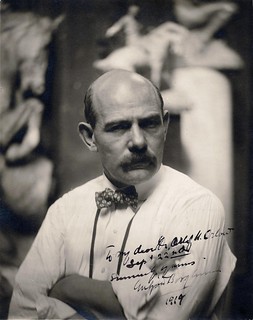 Gutzon Borglum—progeny of Mormon Danish immigrants, product of Parisian art schools, KKK member, friend of Theodore Roosevelt—was a sculptor in many mediums. His most famous work was in stone; it was he who oversaw the creation of Mount Rushmore, and he who launched the work on the Stone Mountain memorial before being fired. But he was also a capable artist in marble and bronze, including a numismatically-relevant statue of John William Mackay, a Bonanza King of the Comstock lode.
Gutzon Borglum—progeny of Mormon Danish immigrants, product of Parisian art schools, KKK member, friend of Theodore Roosevelt—was a sculptor in many mediums. His most famous work was in stone; it was he who oversaw the creation of Mount Rushmore, and he who launched the work on the Stone Mountain memorial before being fired. But he was also a capable artist in marble and bronze, including a numismatically-relevant statue of John William Mackay, a Bonanza King of the Comstock lode.
One medium he was less talented in was that of coinage. Borglum was charged with designing the 1925 Stone Mountain Memorial half dollar (after being a driving force behind its authorization), but his plaster models were rejected nine separate times by the Commission of Fine Arts, led by James Earle Fraser. The Commission generally considered his designs inartistic.
His case was not helped by the fact that, in the words of numismatists William D. Hyder and R.W. Colbert, Borglum, to put it mildly, was a temperamental artist who managed to offend most everyone with whom he worked.
Borglum was a member of the American Numismatic Society between 1908 and 1916, according to correspondence digitized by the Newman Numismatic Portal. In that time, perhaps his most notable contribution to the Society was that of a 1910 membership medal he designed, with dies created by Tiffany & Co.. A letter on the NNP from Bauman L. Belden, Director of the ANS at that time, dictates to Borglum which medals should be struck in advance of offering to the general membership. Included are two gold pieces to Archer M. Huntington and King Victor Emmanuel III of Italy and 14 silver pieces to collectors such as soon-to-be-deposed President of Mexico Porfirio Diaz.
A glimpse into Borglum's personality is possible through the archived correspondence. When asked by Belden about what his membership medal represents, Borglum replied simply by restating the literal design on the medal and noting that it does not seem to me that it is anything one need write very much about.
Image: Gutzon Borglum, courtesy of Wikipedia
Link to Gutzon Borglum / ANS correspondence:
https://archive.org/details/borglumgutzon19000amer/page/19/mode/1up
WASHINGTON UNIVERSITY STORIES FROM WWII
Newman Numismatic Portal Project Coordinator Len Augsburger provided the following report on a new exhibit. Thanks. -Editor
Washington University Opens Stories from WWII Exhibit
Anchored by the Walter Goldschmidt letters, Olin Library at Washington University in St. Louis has opened a new exhibit in the Newman Tower library gallery. Born in Germany in 1922, Goldschmidt came to the United States in 1936 and was drafted into the U.S. Army in 1943. He returned to Europe as a translator in this capacity, including Germany and other countries. Numismatics is not far behind, and this exhibit also includes concentration and internment camp money from Steve and Ray Feller, in addition to war bonds from the collection of Joe Boling. Visitors may also view the Newman copy of the Declaration of Independence, a rare, early broadside example from Rhode Island, which is on permanent display at the library.
Images: Boling exhibit, Feller exhibit
VIDEO: 2022 SUMMER FUN SHOW COMMERCIAL
These are selections from the David Lisot Video Library that feature news and personalities from the world of coin collecting. David has been attending coin conventions since 1972 and began videotaping in 1985. The Newman Numismatic Portal now lists all David's videos on their website at:
https://nnp.wustl.edu/library/multimediadetail/522852
This one is the television commercial for the July 2022 Summer FUN Show. -Editor
Florida United Numismatists Summer Coin Convention 2022 Television Commercial
VIDEO: 00:30
Are you tired of being cooped up at home with nothing to do? Want to see valuable gold coins? How about silver bullion? What about rare coins worth thousands of dollars? Then come to the FUN Coin Convention, Thursday through Saturday, at the Orange County Convention Center.
Buy American Silver Eagles, Learn about paper money from the Old West, Attend seminars about coin collecting, and receive FREE appraisals for your coins and money.
Bring the whole family to the Orange County Convention Center! This Thursday thru Saturday. Doors open daily at ten. Admission is FREE!
David adds:
"It is time again for the FUN Summer Convention. FUN works to put on one of the most user-friendly coin shows in the United States. The convention is not as large as the annual January show but still offers a world class presentation of dealers, exhibits, educational lectures, and numismatics."
FUN Secretary and Convention Coordinator Cindy Wibker writes:
"Summer FUN is alive and healthy. Last year it grew from 200 to 282 booths due to shows being cancelled because of COVID. I was curious to see what would happen this year and we're remaining at a healthy 280+ booths. Should be a good one!"
An excerpt of the video is available for viewing on the Coin Television YouTube Channel at:
https://youtu.be/HVnMvLPDClY
For more information on the show, see:
http://www.funtopics.com/summer-fun.html
MORE ON GARY SNOVER
Fred Schwan edits the MPCGram, an email newsletter for collectors of Military Payment Certificates and other military numismatica. In the latest issue, he remembers paper money dealer Gary Snover. With permission, we're publishing an excerpt here. -Editor
I do not know when Gary started dealing or collecting paper money, but he was established and well known when I started collecting MPC in 1973! At that time Gary was also collecting MPC. Throughout his career, Gary found things to collect that others did not. That is why he collected MPC--few collectors even knew what it was and virtually no one collected it. Very shortly thereafter Gary discontinued collecting MPC because too many people were doing it!
He moved on to MPC replacements. Of course I too collected MPC replacements. I might have had five pieces. I remember very well receiving a letter from Gary including his checklist grid of MPC replacements. In the respective square he listed the grade and most importantly the serial number of the replacement in his collection.
I was astounded to see how many replacements he had! I still have that grid somewhere here in the black hole. When I find it next, I will publish it somewhere so that not only can we see it now, but also so collectors in another 50 years can see this important record. Oh yes, Gary had 17 different replacements.
Al Menke was one of the main collectors of military notes at the time. In a headline move, Gary bought the Menke collection! About the same time, Gary sold his bank note business to the famous Stanley Gibbons stamp company which had aggressively moved into paper money. I am not sure which of those two events was first.
For many years when I saw Gary at a show I called him Mr. Gibbons. He always smiled. I think that I even did that just a few years ago when I last saw Gary.
To subscribe to MPCGram, see:
https://guide.us13.list-manage.com/subscribe?u=10eb366ab80344a56657e0d5d&id=58874b37e1
Christof Zellweger of Switzerland writes:
"With great sadness I had to learn that Gary passed away. I remember well that I bought my first four Albanian regional notes from him in the early 1990's. I still wonder where he got those from. Now those four notes have been accompanied by many many more. May he rest in peace!"
Pete Smith writes:
"I noticed that the article on Gary Snover did not include a definitive date of birth. I found a little additional information.
"Gary Franklin Snover was born on November 25, 1938, the son of Frank and Maye Snover. His father was a carpenter.
"Snover married Lola F. Ryan on April 21, 1970."
To read the earlier E-Sylum article, see:
GARY SNOVER (1938-2022)
(https://www.coinbooks.org/v25/esylum_v25n25a07.html)
NOTES FROM E-SYLUM READERS: JUNE 26, 2022
On Numismatic Auctions and In-Person Bidding
Regarding the fate of live numismatic auctions, Stack's Bowers Galleries
Senior Numismatist and Auctioneer
Ben Orooji writes:
 "I am happy to report that Stack's Bowers Galleries has no intentions of eliminating live auctions. In fact, we've built a beautiful studio at our headquarters in Costa Mesa, CA specifically for the purposes of showing our live auctions all over the world in high definition that makes you feel as if you're
"I am happy to report that Stack's Bowers Galleries has no intentions of eliminating live auctions. In fact, we've built a beautiful studio at our headquarters in Costa Mesa, CA specifically for the purposes of showing our live auctions all over the world in high definition that makes you feel as if you're right there
even if you're watching on a screen. Of course if you would like to come to our studio and bid live in-person we will wholeheartedly welcome you and will have snacks, drinks and meals provided. Many bidders do so.
"Me and my fellow auctioneers and our studio managers keep working hard to make our live auctions exciting events that rival the best of the best art auction houses. We are confident when we say we think our live auctions are the finest among our numismatic competitors and invite you to watch them anytime. All of our recent sales are archived on YouTube. During the live auctions you can watch from our website, on our smartphone app, on YouTube and on Facebook Live."
It's a whole new world, and will take some getting used to. Having lot viewing at major shows with the auction itself taking place afterwards does make shows more relaxing. But for most bidders, travelling to a second location to bid in person is cost prohibitive. Yet as everyone's at-home technology and room setup improves, I think more bidders may be willing to drop their anonymity and fully participate in ways similar to the old style in-person sales (as Chris MacDowell recalls)- kibitzing, position-jockeying, trash-talking and cheering their fellow bidders as new records are set and new collections created and completed. The platforms aren't there yet, but such features could be possible one day. -Editor
Ben adds:
"You are correct that remote bidders cannot interact with each other on our platform. A major benefit here is that you are anonymous and a beginning collector has equal footing with the most seasoned among us. Yes, the
in-person trash talking is eliminated, but collectors can do the same over Facebook, the Collectors Universe forums or Discord channels if they like. It's a different experience for sure, but I'll be honest here: when I began collecting real
auction-worthy coins in the era of auctions in conjunction with shows I was incredibly intimidated. Today I wouldn't be of course, but I definitely would have appreciated the prevalence of online bidding while watching the sale that is currently the standard. To the dealers, this could present a disadvantage but I can't imagine a situation where this hurts the collector.
"Regardless, I'll submit your feedback and online interaction idea to the team here at SBG. Maybe there are others who are thinking along the same lines."
Good points. Just because technology COULD enable something doesn't always mean it SHOULD. I agree with Chris that something positive has been lost yet I'm glad there are already some alternate channels available. It just takes some coordination among the participants to initiate what happens naturally when a bunch of coin-crazed people are all in a physical room together. -Editor
Alan V Weinberg writes:
"I've attended live coin auctions since 1958 (Parke Bernet hotel 57th & 6th Ave NYC) and they've always been a major attraction at shows, attracting many collectors and dealers who otherwise might not have attended the show itself. With the catalogues themselves serving as reference material for many decades thereafter - like the John Ford auction series of nearly 30 separate auction catalogues.
"On the other hand, there is the solid argument that such on-site show auctions pull buyers off the bourse floor and cause potential bourse buyers to avoid spending on the bourse floor in favor of perhaps buying at the auction itself later that evening or even 1-2 days later.
"Additional auctioneer expenses at shows include large room rental and chair & table rentals, catered food & drinks for lunch/ dinner (more than a decade ago one major auctioneer told me a catered can of soda cost them $3 each THEN), per hour employees (likely working overtime) monitoring the bids, auctioneer expense, extra security, etc. There are considerable savings if only lot viewing occurs simultaneously with a show. Well, you say they get 20-25% buyers fee. Well, those fee figures are now a decade+ old and we all know what inflation has occurred.
"So, our concern now should be continued physical publication of the auction catalogues, NOT just online listings. There are so many arguments for keeping in-hand auction catalogues being issued. Stack's Bowers told me a decade ago that a major auction catalogue cost them, start to delivery, $35 each. Heritage has in-house publication and mailing so their costs may be somewhat less. But again that $35 per catalogue cost was over a decade ago. Mailing costs alone have skyrocketed."
To read the earlier E-Sylum article, see:
THE DEMISE OF LIVE AUCTIONS?
(https://www.coinbooks.org/v25/esylum_v25n25a14.html)
More on Browning's Early Quarter Dollars
Regarding my audio recording of the 1991 Numismatic Bibliomania Society Symposium and John Ford's discussion of A.W. Browning's 1925 Early Quarter Dollars book,
Joel Orosz writes:
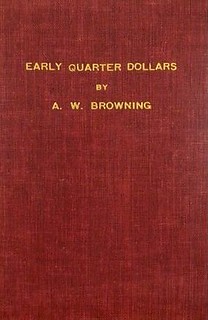 "I have one of the five interleaved copies, ex Ted Craige and John W. Adams. It is exactly as Kellen described it: it appears to be crimson half morocco with crimson and green marbled paper sides and pastedowns, but a closer examination reveals that what appears to be morocco is actually a pebbled cloth. There is gilt lettering on the spine, but none on the covers, as in your illustrated regular edition copy. It contains the 1925 Wayte Raymond reprint, and eight linen-backed reprint plates.
"I have one of the five interleaved copies, ex Ted Craige and John W. Adams. It is exactly as Kellen described it: it appears to be crimson half morocco with crimson and green marbled paper sides and pastedowns, but a closer examination reveals that what appears to be morocco is actually a pebbled cloth. There is gilt lettering on the spine, but none on the covers, as in your illustrated regular edition copy. It contains the 1925 Wayte Raymond reprint, and eight linen-backed reprint plates.
"The plates are really superb, and have remained so because the interleaving has prevented them from rubbing against the coarse linen backing of the preceding plate. This rubbing problem affects most of the original 1925 Raymond reprints and the regular 1950 Ford issue. The special edition thus passes the test for usefulness as a reprint of an important text.
"I am so glad, Wayne, that you preserved the 1991 NBS Symposium on tape, and that Len and Kellen were able to successfully digitize it. I remember sitting rapt through all of the presentations, and hearing it again after 31 years have passed will be a real treat. It's gratifying to note that three of the five speakers are still with us all those decades on."
The tape is a real gem, and many thanks to the Newman Numismatic Portal for digitizing and sharing it. -Editor
To read the earlier E-Sylum article, see:
JOHN FORD SPEAKS ON THE BROWNING REPRINT
(https://www.coinbooks.org/v25/esylum_v25n25a09.html)
The 1,000 oz. Bullion Scale
Curious, I reached out to Jan Monroe for more information on the scale he's advertising to sell. He can be reached at maent65@gmail.com . -Editor
"The history of the scale is that it was purchased by the US Government and at some point sold. It was then owned by the Northwest Territorial Mint. I purchased it at a subsequent auction. I do not know which part of the US Government owned the scale but I would certainly like to. I can't imagine that there are very agencies that would need a 1,000 oz. Bullion scale."
Compass Point Currency Names
Martin Purdy writes:
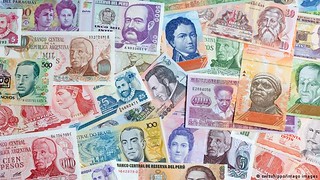
"Tickled by the idea of "sur" (south) as the proposed name for a unified Latin American currency: after all, that was the literal meaning of Argentina's "austral" back in the 1980s, so the concept of a compass point for a unit of currency isn't entirely new."
The origins and meanings of currency names would make an interesting study. Perhaps someone has already written one. Is anyone aware of a comprehensive book or thesis? Of course, the internet is full of short articles and lists. Here are a few I found for your reading pleasure. -Editor
To read the complete articles, see:
Origins of World Currency Names
World Currencies and their etymological origins
(https://www.mintageworld.com/blog/world-currencies-etymological-origins/)
How the world's currencies got their names
(https://www.businessinsider.com/how-currency-got-their-names-2016-6)
To read the earlier E-Sylum article, see:
A SINGLE LATIN AMERICAN CURRENCY?
(https://www.coinbooks.org/v25/esylum_v25n25a30.html)
More on the 1875 William Douglas Catalog
David Fanning writes:
"Dave Hirt has asked about the 1875 catalogue issued by William Douglas, of Zanesville, Ohio. We've handled two or three copies of that over the years, and I had a copy in my own library at one point. It's pretty rare, but not unheard of. The catalogue offers a nice range of material for the time, including paper money and ancient coins in addition to the U.S. and modern foreign coins one might expect. Zanesville was pretty far off the beaten track at the time (still is, I suppose, though I know one or two numismatists in the area)."
Thanks! -Editor
To read the earlier E-Sylum article, see:
NOTES FROM E-SYLUM READERS: JUNE 19, 2022 : Query: 1875 William Douglas Auction Sale
(https://www.coinbooks.org/v25/esylum_v25n25a11.html)
The Case of the Missing Pages
Chriss Hoffman writes:
"I've been going through my library and trying to read some of the books I had not gotten around to completing or at least flipping through, in doing this I've come across a book with missing pages.
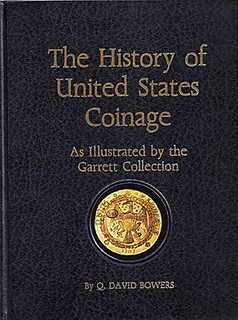 "In "History of United States Coinage as Illustrated by the Garrett Collection" by Q. David Bowers, I found a section of 24 pages missing (pages 241 through 264), I have several copies of this book and none of the others have this problem. There are no indications the pages were removed as the binding is still tight as new. This book is a first edition, I'm sure of, as no indication of any other editions nor revisions are on the 1979 copyright page information.
"In "History of United States Coinage as Illustrated by the Garrett Collection" by Q. David Bowers, I found a section of 24 pages missing (pages 241 through 264), I have several copies of this book and none of the others have this problem. There are no indications the pages were removed as the binding is still tight as new. This book is a first edition, I'm sure of, as no indication of any other editions nor revisions are on the 1979 copyright page information.
"I wonder if any other readers have the same issue with this book, or possibly never noticed it. I only did so, as at the end of page 240 the word is hyphenated to continue on to the next page... It of course never does, which is what led me to flipping pages thinking I had missed some text or a page was stuck before I realized the page numbers had jumped ahead by 20+ pages.
"It's still one of my favorite books ever written on the subject of American coinage, and I cherish my other copy given to me by Q. David Bowers when I was a YN attending his course "All about coins" at the ANA Summer Seminar in 1981, it's complete with no missing pages and it's a third printing, even if it's much more worn from reading and rereading over the years."
My copy is the second printing, and those pages are present. Has anyone else seen this problem? -Editor
To read earlier E-Sylum articles, see:
BOOK REVIEW: HISTORY OF U.S COINAGE - GARRETT COLLECTION
(https://www.coinbooks.org/esylum_v18n22a05.html)
DAVE BOWERS AND THE GARRETT COLLECTION
(https://www.coinbooks.org/v21/esylum_v21n47a07.html)
2007-P Washington Dollar Ray Variety Certified
Tom Koolick provided this update to his April 3, 2022 article:
"The Numismatic Guaranty Company (Variety Plus, Mr. Dave Lange) has certified this 2007-P Washington Dollar, Elongated Ray Variety."
Thanks, and congratulations on a nice find. -Editor
To read the earlier E-Sylum article, see:
2007-P WASHINGTON DOLLAR ELONGATED RAY
(https://www.coinbooks.org/v25/esylum_v25n14a25.html)
NORTHWEST TERRITORIAL MINT SENTENCES
The U.S. Attorney's Office for the Western District of Washington announced the sentencing of the captured fugitive former executives of the Northwest Territorial Mint. -Editor
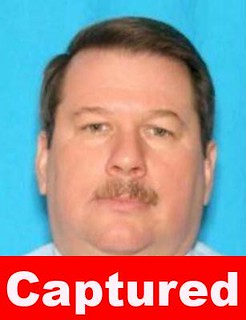 The former President & CEO of Northwest Territorial Mint, a now-bankrupt company dealing in precious metals, was sentenced today in U.S. District Court in Seattle to 11 years in prison for 14 federal felonies resulting from a Ponzi-like scheme that defrauded customers of millions of dollars, announced U.S. Attorney Nick Brown. Bernard Ross Hansen, 61, aka Ross B. Hansen was convicted of multiple counts of wire and mail fraud after a four-week jury trial in July 2021. Hansen's co-defendant and partner, Vault Manager Diane Renee Erdmann, 49, was convicted of 13 counts of wire fraud and mail fraud. She was sentenced to five years in prison. This was the second scheduled sentencing hearing for the two after they failed to show up for their late April court date and attempted to flee.
The former President & CEO of Northwest Territorial Mint, a now-bankrupt company dealing in precious metals, was sentenced today in U.S. District Court in Seattle to 11 years in prison for 14 federal felonies resulting from a Ponzi-like scheme that defrauded customers of millions of dollars, announced U.S. Attorney Nick Brown. Bernard Ross Hansen, 61, aka Ross B. Hansen was convicted of multiple counts of wire and mail fraud after a four-week jury trial in July 2021. Hansen's co-defendant and partner, Vault Manager Diane Renee Erdmann, 49, was convicted of 13 counts of wire fraud and mail fraud. She was sentenced to five years in prison. This was the second scheduled sentencing hearing for the two after they failed to show up for their late April court date and attempted to flee.
At the sentencing hearing U.S. District Judge Richard A. Jones said, The entire means of operation was nothing more than a fiction…. You were a wrecking ball building your empire. (The victims) trusted you and had faith in the snake oil you were selling; that faith was met with manipulation and deceit.
Mr. Hansen and Ms. Erdman defrauded more than 3,000 people of some $30 million – money that represents the victims' plans and dreams: retirement, college funds, and inheritances,
said U.S. Attorney Nick Brown. It is heartbreaking to hear how the fraud upended their lives and left them working longer, harder, and in deep stress to try to recover. The impact of this fraud goes beyond the significant dollar figure.
Northwest Territorial Mint (NWTM) operated both a custom business that involved the manufacturing of medallions and other awards, and a bullion business that involved the selling, buying, exchanging, storing, and leasing of gold, silver, and other precious metals. The company had offices in Federal Way and Auburn, Washington, but declared bankruptcy on April 1, 2016.
According to records in the case and testimony at trial, Hansen and Erdmann defrauded NWTM customers in a variety of ways. The evidence at trial showed that Hansen and Erdmann lied about shipping times for bullion, used customer money to expand the business to other states, and to pay their own personal expenses. As a result, the company lacked enough assets to fulfill customer orders and used new customer money to pay off older customers in a Ponzi-like scheme. In total, over 2500 customers paid for orders, or made bullion sales or exchanges, that were either never fulfilled or never refunded. The total loss to these customers was more than $25,000,000.
In addition to the bullion customer fraud, the evidence at trial demonstrated that Hansen and Erdmann defrauded customers who paid NWTM to safely and securely store bullion in the NWTM vaults. Evidence and testimony at trial showed that Hansen and Erdmann used this bullion that was supposed to be in secure storage to fulfill other orders. In April 2016, the NWTM vaults were inventoried and all or part of the stored bullion for more than 50 customers was missing. The missing bullion was worth more than $4.9 million.
Writing to the court, prosecutors pointed out the deception against the storage customers: Mr. Hansen talked (the storage customers) into paying NWTM to steal from them—forking over fees, sometimes thousands of dollars' worth, to
securely
store their bullion at NWTM, only to have the defendants use the vault as a company piggy bank. Mr. Hansen collected those fees and delivered phony storage account statements in return. But unbeknownst to the storage customers, Mr. Hansen used the storage customers' bullion as his own – pulling it off the shelf to fulfill other orders, at times even melting down customers' property to makes something else to ship somewhere else.
Company president Hansen apparently did not learn his lesson from his last trip to prison,
said Donald M. Voiret, Special Agent in Charge of the FBI Seattle Field Office. Together, Hansen and his co-conspirator Ms. Erdmann stole decades of savings and financial security from thousands of victims who thought they were making safe investments for themselves and their loved ones.
To read the complete article, see:
Pair who went on the run after being found guilty of fraud at a now defunct precious metals firm, sentenced to prison
(https://www.justice.gov/usao-wdwa/pr/pair-who-went-run-after-being-found-guilty-fraud-now-defunct-precious-metals-firm)
To read the earlier E-Sylum articles, see:
LOOSE CHANGE: MAY 8, 2022 : FBI Seeks Former Northwest Territorial Mint Officials
(https://www.coinbooks.org/v25/esylum_v25n19a35.html)
NOTES FROM E-SYLUM READERS: MAY 20, 2022 : FBI Most Wanted, Supermodels, and Dismes
(https://www.coinbooks.org/v25/esylum_v25n20a08.html)
U. S. MINT CANVAS BAGS
Dave Lange submitted these notes on U. S. Mint canvas bags. Thanks! -Editor
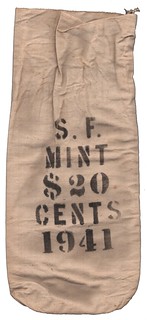 Recently, a long-time friend of mine who deals in all sorts of numismatica emailed me to say he'd sold some U. S. Mint canvas bags on eBay and discovered that the buyer is an NGC grader. I confirmed that fact and mentioned that I, too, have a modest collection of Mint and Treasury bags. This prompted me to look for them in the valley of forgotten collectibles that is my hobby room. I'm attaching scans I made of some of the more interesting pieces.
Recently, a long-time friend of mine who deals in all sorts of numismatica emailed me to say he'd sold some U. S. Mint canvas bags on eBay and discovered that the buyer is an NGC grader. I confirmed that fact and mentioned that I, too, have a modest collection of Mint and Treasury bags. This prompted me to look for them in the valley of forgotten collectibles that is my hobby room. I'm attaching scans I made of some of the more interesting pieces.
The first is a bag that formerly held $20 in 1941-S cents. Some time ago there was a debate on one of the message boards about whether cents were shipped in less than $50 quantities, and I mentioned having this bag. I find it particularly amusing that the font of the "S" in the word "CENTS" printed on the bag is similar in style to the somewhat scarce Large S variety of 1941-S cents---probably just a coincidence.
The next example demonstrates how the Mint re-used bags after they'd been returned by the recipient bank. It's stamped for $1000 in 1971-D half dollars, but partially obscured on the other side is text revealing that it formerly held 1966 dimes. Since the Mint wasn't including mintmarks for coins dated 1965-67 there is no indication of which facility produced said dimes.
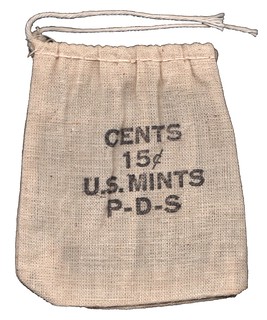 The last item is one of the U. S. Mint's souvenir "mini bags." These were sold to collectors by mail and to mint tourists onsite during the early 1970s, and each 15-cent bag contained five cents from the Philadelphia Mint, five from the Denver Mint and five from the San Francisco Assay Office. I believe they were first offered in 1970 and then produced annually through 1973. This example formerly held cents dated 1973, and I purchased it by mail that year. When Mint Director Mary Brooks got fed up with speculators hoarding S-Mint cents and contributing to the cent shortage in 1974 she ordered that the souvenir bags be discontinued. At some point I emptied the bag, saving only the finest cent from each mint for my collection and spending the rest.
The last item is one of the U. S. Mint's souvenir "mini bags." These were sold to collectors by mail and to mint tourists onsite during the early 1970s, and each 15-cent bag contained five cents from the Philadelphia Mint, five from the Denver Mint and five from the San Francisco Assay Office. I believe they were first offered in 1970 and then produced annually through 1973. This example formerly held cents dated 1973, and I purchased it by mail that year. When Mint Director Mary Brooks got fed up with speculators hoarding S-Mint cents and contributing to the cent shortage in 1974 she ordered that the souvenir bags be discontinued. At some point I emptied the bag, saving only the finest cent from each mint for my collection and spending the rest.
MORE ON ZERBE AND THE 1909 ANA ELECTION
Douglas Ward of Santa Ana, CA submitted this article on Farran Zerbe and the 1909 ANA election, rebutting a number of claims made over the years against Zerbe as addressed in David Alexander's 2016 CoinWeek article on the topic. -Editor
 Farran Zerbe's unceremonious removal from the ANA's highest award and its recent renaming both had a basis in Mr. David Alexander's CoinWeek article
Farran Zerbe's unceremonious removal from the ANA's highest award and its recent renaming both had a basis in Mr. David Alexander's CoinWeek article Farran Zerbe, Numismatist • Promoter • Hustler
. Below are excerpts:
Zerbe developed remarkable skill in self promotion. The Pittsburgh Times of March 11, 1903, reported his gaudy proposal for the creation of a monstrous gold coin for the upcoming Louisiana Purchase Exposition (LPE) to be held in 1903-1904 in Saint Louis. This unique piece would have a diameter of 40 feet and a thickness of 30 inches. Its nominal face value would be $1,000,000,000. This proposal gagged the U.S. Mint, reinforced appraisal of Zerbe as a huckster and was never carried out.
By all accounts, Mr. Zerbe was a smart and motivated man. As such, this was undoubtedly an exercise of the imagination, rather than a serious proposal. Referring to the article appearing in The Pittsburg Press on March 11, 1903, the context of his proposal is quickly understood:
Mr. Zerbe is on his way to St. Louis where he goes to make arrangements for an exhibit of his curiosities at the World's Fair next year. One of the features of the show will be a fac-simile of what a billion-dollar gold piece would look like if such a coin were made. It will consist of metal representing gold and will be 40 feet in diameter and 30 inches thick.
It seems the fac-simile
coin was never made, but it certainly wasn't to be made of gold. As an ‘imaginary' coin and marketing tool, the U.S.
Mint would not have had a comment.
Here's another excerpt:
The notably modest Heath had shunned high office up to this point while personally maintaining The Numismatist.
Dr. Heath held an ANA office in most years before his death, including President in several. This statement makes the combination of Mr. Zerbe's ANA presidency and ownership of The Numismatist seem dangerous and without precedent – That was not the case.
Regarding the 1909 ANA elections:
The NYNC leadership could not access the ANA mailing list to distribute its skillfully compiled campaign booklet spelling out far-reaching improvement of the national organization.
The ANA membership list was mailed yearly to all members, beginning in October of 1908. The addresses of new members were printed in each edition of The Numismatist.
Here's another:
However reasonable the NYNC program may have been, Zerbe had control of the
Official Organ
and mailing list and used both ruthlessly to advance Henderson's candidacy and to misrepresent the Higgins platform. No pro- Higgins material was allowed to appear in The Numismatist but any opposing views by members of that club were trumpeted.
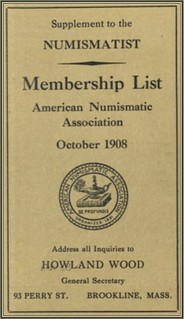 As mentioned, the mailing list was sent to all members. The Numismatist policy was to only print
As mentioned, the mailing list was sent to all members. The Numismatist policy was to only print letters advocating candidates… as advertising
and letters opposing candidates [would] not be published.
The little political material appearing in The Numismatist rightly called out Methods emanating from New York
as entirely foreign to what has governed the A.N.A. in the past.
No material was published that ‘ruthlessly advance[d] Henderson's candidacy,' or misrepresent[ed] the Higgins Platform.
Only one letter advocating Dr. Henderson was printed as a paid advertisement. It's impossible to prove if any pro-Higgins material
was ever sent as advertising to The Numismatist, let alone if its publication was not allowed. Given the adversarial relationships, it highly probably no letters from the Higgins campaign were ever sent. Rather, it seemed Mr. Higgins preferred Mehl's Numismatic Monthly for the publishing of his campaign statements.
And another:
Zerbe, the tokens' target, was now frantic with anger and used the
Official Organ
against his opponents by opening its pages to any messages hostile to Higgins and Elder to such a degree that a number of prominent collectors including Chicago's millionaire Virgil M. Brand resigned in protest of the corruption of The Numismatist.
Mr. Alexander miss-represents Mr. Brand's resignation. As stated in Mr. Q. David Bowers' book, The ANA Centennial History; Virgil M. Brand, America's leading private collector at the time, was so annoyed with ANA politics in 1909 that he resigned from the organization.
The use of character assassination and mud slinging by the Higgins campaign was more likely responsible for Mr. Brand's resignation. Those tactics were widely unpopular and likely a cause of Mr. Higgins' defeat. He also fails to mention opposition to the Higgins campaign tactics from within the NYNC itself, including from Mr. Jules de Lagerberg and the resignation in protest of Mr. Niklewicz.
And another:
Inserted with the August issue was a 56-inch scroll,
The ANA Campaign and its Questions, the Association Defiled and Defied
, identified by its sometimes casual grammar as the work of Zerbe himself. ANA by-laws of the time allowed all members to submit a written proxy vote if they were unable to attend the convention.
This scroll would be the last thing ANA members would see before filling out their proxies.
By stating it was identified by its sometimes casual grammar as the work of Zerbe himself,
Mr. Alexander infers that the scroll's authorship was anonymous and it therefore lacks some validity and resolve. However, Mr. Zerbe's name appears in the by-line, By Farran Zerbe, Publisher of The Numismatist.
9 The double height, doubled sided, double folded insert
is a well written, pure defense and rebuttal to the character assassination mounted by Mr. Elder and Mr. Higgins during the campaign. Contrary to Mr. Alexander's statement, its inclusion in the August issue meant it would not be seen by members prior mailing their ballot or proxy, since the convention began on August 9th. As Mr. Zerbe stated in the first and then last paragraphs:
The A. N. A. has had a political campaign to be remembered for its methods. We state this as of the past for the reason that we believe the campaign is over and the mail ballots, which will have been executed before this reaches our members, will govern the results. So that anything we may now say will not be received in time to be an influence for or against the election chances of any candidate.
This is written August 3d and would not be published had we not received from numerous sources the question,
How can you keep silent? The Convention may take action, but by the time it is published the subject will be old and your silence may lead to unjust conclusions.
And then there's the infamous ‘blank proxies' allegation:
In preparing his massive two-volume ANA Centennial History in 1991, researcher Q. David Bowers revealed that Zerbe printed and carried 200 blank proxies with him to Montreal,
just in case.
There is no such statement in Mr. Bowers' book. This patently falsified claim has been since repeated a number of times, including most recently in a YouTube video history of Mr. Zerbe where the number has increased to ‘400 blank proxies.' This accusation appears to originate from Mr. Higgins' political booklet that predated the convention; Having exhausted the resources of buncombe and invective to make a showing of fitness for office, they are in the last throes of distress setting about monkeying with the ballots of the voters.
Mr. Zerbe decries this accusation in his editorial of August, 3rd. It has since grown by exaggeration and gained an infamous life of its own.
These are the primary examples of Mr. Alexander's misrepresentations, although there are others. Taken together, the disparaging of a previously well respected and pioneering numismatist is regretful. The removal of Mr. Zerbe's name from the ANA's highest award was based on these accounts and related accusations, as recounted in the ANA press release and infamous ‘16 to 1' letter. One only needed to read the last statements in Mr. Alexander's article to understand his true motivation:
Time passed, and Zerbe's role in the early years of the ANA gradually faded from public view. During 2016, Chester L. Krause died.
Chet
was widely admired as the founder of Numismatic News and Krause Publications with its extensive roster of books. Proposals were received for the renaming of ANA's top service recognition as the Chet Krause Award.
REFERENCES:
Farran Zerbe, Numismatist • Promoter • Hustler
, by David T. Alexander, Coin Week, September 27, 2016.
Collection of Ancient Coins
The Pittsburg Press, March 11, 1903, page 6. Note: The Pittsburg Times ceased publication in 1906 and the referenced article could not be found. Its presumed The Pittsburg Press article of the same date contained the same content.
Membership List, American Numismatic Association,
Supplement to the Numismatist, October, 1908.
Editor's statement, Farran Zerbe, Managing Editor and Publisher, The Numismatist, June, 1909, page 176.
A. N. A. Campaign Methods Deprecated.
Editorial, Farran Zerbe Managing Editor and Publisher, The Numismatist, July, 1909, page 208.
Things to be Considered in the A. N. A. Campaign
by F. G. Duffield, The Numismatist, July, 1909, page 221.
The American Numismatic Association Centennial History, Volume 1,
by Q. David Bowers, Bowers and Merena Galleries, Inc., 1991, pages 209 - 212..
Mr. Niklewicz, Secretary of the New York Numismatic Club, Withdraws From Its Campaign Committee.
Letter to the Editor from Herbert Niklewicz, The Numismatist, August, 1909, page 241.
Concerning the
By Douglas Ward, The E-Sylum, Vol. 25, No. 9, February 27, 2022, Article 19.
Blank Proxy
Allegation form the 1909 ANA Election.
The A. N. A. Campaign and Its Question. The Association Defiled and Defied.
By Farran Zerbe, A ‘loose leaf ‘ addition in The Numismatist, August, 1908, page 4. Note; Thanks to David Hill of The American Numismatic Society for providing a copy of this document.
To read David Alexander's CoinWeek article, see:
Farran Zerbe: Numismatist – Promoter – Hustler
(https://coinweek.com/education/farran-zerbe-numismatist-promoter-h)
To read earlier E-Sylum articles, see:
ZERBE NAME REMOVED FROM ANA TOP AWARD
(https://www.coinbooks.org/v24/esylum_v24n39a17.html)
THE 1909 ANA ELECTION BLANK PROXY BALLOTS
(https://www.coinbooks.org/v25/esylum_v25n09a19.html)
TOP ANA AWARD NAMED FOR CHESTER L. KRAUSE
(https://www.coinbooks.org/v25/esylum_v25n18a19.html)
VOCABULARY TERM: JUGATE
Here's another entry from Dick Johnson's Encyclopedia of Coin and Medal Terminology. -Editor
Jugate. Two or more portraits joined side-by-side and overlapping to form the device appearing on one side of a numismatic item. The portraits face the same direction and the term is similar to accolated and conjoined, opposite of vis-a-vis (where the heads are facing each other). The term for one or more heads on both sides of a numismatic item is bijugate. See also portraits and portraiture.
Reference:
NE42 {1982} Doty, p 182-183.
An NGC Ancients article nicely describes the topic - here are a couple examples. Note the term "confronted" for two portraits facing one another. -Editor
We'll start with the jugate-style portraits on a 19mm bronze coin (above) struck in about 10 B.C. at the provincial mint of Smyrna. Produced well after Rome's first emperor, Augustus (27 B.C.-A.D. 14), had consolidated his authority in the Roman world, it shows the portraits of Augustus and his wife, the empress Livia.
Taking the dual-portrait concept a step further, this 21mm bronze from the provincial mint of Magnesia in Lydia shows four members of Rome's first royal family. The obverse presents two portraits jugate (Augustus and Livia) and the reverse shows two confronted (Augustus' grandsons and heirs, Caius and Lucius).
Why stop at two portraits? Is there a word for a coin image with three portraits? -Editor
We'll end this brief survey with another rare and remarkable coin depicting three emperors. This billon double-denarius was produced in Britain, perhaps in A.D. 292, by the rebel-emperor Carausius (A.D. 286/7-293). He took the bold and presumptuous step of portraying himself with his two sworn enemies, the official Roman emperors Diocletian and Maximian. The coin is inscribed CARAVSIVS ET FRATRES SVI (‘Carausius and his brothers'), seemingly in the hope it might help spawn friendly relations or would deceive his subjects into believing such relations actually existed.
To read the complete NGC article, see:
NGC Ancients: Jugate and Confronted Portraits on Ancient Roman Coins
(https://www.ngccoin.com/news/article/8531/)
To read the complete entry on the Newman Numismatic Portal, see:
Jugate
(https://nnp.wustl.edu/library/dictionarydetail/516185)
FRANK JOHN JOSEPH (1838-1895)
American Numismatic Biographies author Pete Smith submitted this article on Canadian collector Frank John Joseph. Thanks. -Editor
This week I came across an unfamiliar name that got my attention. Of Frank John Joseph,
Wikipedia stated Reportedly had one of the finest private collections of coins and medals in
North America worth an estimated $30000 at his death.
He was not mentioned by Attinelli (A
Bibliography of American Numismatic Auction Catalogues 1828-1875); not mentioned by
Bowers (American Numismatics Before the Civil War); not in the Centennial History of the
A.N.A. In fact, I did not find him in any book in my library.
Perhaps the first problem is that he was Canadian. He was born in Toronto on June 5, 1838, the son of John Joseph and Elizabeth-Anne Macaulay. He was unmarried.
He was a barrister at law and served as a law clerk in the Ontario legislature. He was the author of legal handbooks including A Digest of the Reported Cases Determined in the Superior Courts of Ontario.
He was described as having the finest collection of British war medals in North America. He also had significant holdings of British, Canadian, United States and ancient coins.
He died in a railroad accident near Toronto on February 8, 1895, and is buried at Cathedral Church of Saint James in Toronto.
His obituary in the American Journal of Numismatics, July 1895, is the only reference on Joseph found on the Newman Numismatic Portal.
I yield to our Canadian readers to explain why he belongs on the Wikipedia List of Coin
Collectors.
Thanks - can anyone help? -Editor
HARVEY STACK'S NUMISMATIC FAMILY, PART 124
Stack's Bowers has a backlog of the late Harvey Stack's numismatic memoir articles and will continue publishing them. In this one Harvey discusses sales from the second half of 1997. -Editor
Our 1997 auction season continued in May with a sale of nearly 1,200 lots of United States coins and paper money featuring the McGreevy Family and Bruce Lawrence collections. While not complete offerings, the quality was nicer than what was usually offered and there was great competition for both common and scarce items by bidders looking to fill holes in their collections. Interest and participation by both collectors and dealers continued to grow as the year went on. ?
June brought our sale of the Schoonmaker Family Collection of Ancient and Modern Coins, over 900 lots that blended historical and popular coinage of gold, silver, and copper. This was a collection that addressed both monetary history and the art found on this array of world currency. Our specialist staff enjoyed cataloging and making historical notes of many of the coins in our auction catalog. Following this offering was another catalog of more than 800 lots that offered the Schoonmaker American coins as well as the Elm Rock Collection of U.S. Colonial Coins.
Stack's opened its fall auction season with our September sale of choice and scarce coins highlighted by the well known Hubert Remick Collection. This catalog included U.S. gold silver and copper coins plus a specialized collection of early American and Canadian copper and U.S. paper money. Highlights included sets of minor coins from small cents to nickel five-cent pieces, as well as twenty-cent pieces, quarters, and commemorative half dollars. Important Proof sets included 1871, 1882, 1884, 1895, and 1900, plus many other Proofs. There was a basic type set of U.S. gold starting in 1795 along with many other popular and outstanding coins that were enthusiastically bid on by both floor and mail bidders.
The October Sale of 1,461 lots featured the outstanding Albert W. Savage Collection of U.S. coins, along with other important consignments. The Savage Collection started as a basic type set and expanded to become a very valuable collection spanning from the earliest dates of American coinage through to current issues. Also include were over 60 pattern coins that were, in many cases, the forebearers of the designs that would become our circulating coinage. This collection had been exhibited at public schools to introduce numismatics to those who were interested in our nation's monetary history.
In December 1997 we were once again honored to conduct auction sales in conjunction with the annual International Numismatic Convention in New York City. For this event we prepared three catalogs, two that focused on world coins and one that offered U.S. coins. In this way we were able to appeal to all the attendees of the convention, no matter what they were interested in collecting. Large attendance at the convention and a record number of bid sheets led to a very successful event.
The first catalog offered ancient and world coins, including the Ancient Greek and Roman Collection formed by Herbert M. Singer, coins from the Catholic Near East Welfare Association, and the Allen F. Lovejoy collection of late Roman and Byzantine gold. In addition, we were pleased to offer the early English Hammered Gold coinage of both Mr. Singer and Mr. Lovejoy, blended together to create a massive offering of this specialty. The sale also featured Renaissance English coinage, early gold Proof sets including the coinage of Victoria, and many other fabulous and rare gold and silver coins. Our world coin offering continued with Ancient Coins of the Islamic World, one of the largest offerings of this highly specialized series ever sold in America. Our cataloging team worked hard to create this stand-alone catalog and make it a reference guide for collectors. Although this was a convention dedicated to the international market, we closed out the year with a catalog featuring over 1,000 lots of United States gold, silver and copper. It was a very positive conclusion to another successful year at Stack's.
To read the complete article, see:
Growing up in a Numismatic Family: Part 124
(https://www.stacksbowers.com/News/Pages/Blogs.aspx?ArticleID=harvey-stack-remembers-124)
To read the earlier E-Sylum article, see:
HARVEY STACK'S NUMISMATIC FAMILY, PART 123
(https://www.coinbooks.org/v25/esylum_v25n24a14.html)
ROSA AMERICANA COLONIAL COINS PRICE LIST #23
E-Sylum supporter Jeff Rock of Rosa Americana, LTD has issued a new fixed price list of U.S. colonial coins. Here's his summary description and some sample pages. Great material here, with excellent writeups. To get your copy, contact Jeff at rosaamltd@gmail.com . -Editor
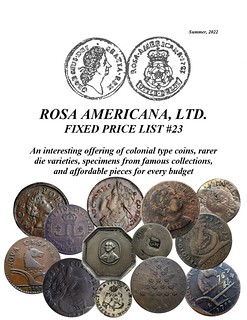 Certainly something of a record for me, this 23rd Fixed Price List of interesting and
affordable colonial coins, tokens, and medals follows fast on the heels of my 22nd list which
came out just four months ago. For those of you who have been on my mailing list for years (or
even decades) you know that lists were often spaced many years apart – one of my goals in
moving from those mammoth lists of 600-700 coins was to put out smaller, more frequent lists,
which has been the case since my 20th Price List, issued in digital format (issued in 2019, 9 years
after the 19th price list was put in the mail!). This smaller number of coins per list means that I
can get the writing done faster, while the digital format makes it feasible to have larger-sized,
high quality, full color photographs of every coin. Because I'm not spending money on printing
and postage it also means that I can go into far greater detail, devoting an entire page of photo
and text to a coin that may have a price of just a couple hundred dollars.
Certainly something of a record for me, this 23rd Fixed Price List of interesting and
affordable colonial coins, tokens, and medals follows fast on the heels of my 22nd list which
came out just four months ago. For those of you who have been on my mailing list for years (or
even decades) you know that lists were often spaced many years apart – one of my goals in
moving from those mammoth lists of 600-700 coins was to put out smaller, more frequent lists,
which has been the case since my 20th Price List, issued in digital format (issued in 2019, 9 years
after the 19th price list was put in the mail!). This smaller number of coins per list means that I
can get the writing done faster, while the digital format makes it feasible to have larger-sized,
high quality, full color photographs of every coin. Because I'm not spending money on printing
and postage it also means that I can go into far greater detail, devoting an entire page of photo
and text to a coin that may have a price of just a couple hundred dollars.
Why? Because the coins are damned interesting, and deserve to have this kind of attention to detail – you like them, and I like them too, and I hope that shows! I am a collector at heart – and the dealing in colonials finances my collecting and allows me to acquire, study, enjoy, and pass along pieces that I may otherwise never have pursued. As a collector, especially one with a limited budget, it means that every piece I buy for my collection – or inventory – has to represent good value for the money.
As a dealer, I do not chase Finest Knowns or Registry Set grades because I don't see those as good value for the average collector, at least not at the price levels they are now at. This view may be due to my being active in the hobby since the late-1970s, and dealing in colonials since 1989 – while I can understand a choice coin being worth multiples of an average one, I just don't see an MS67 being worth 87.32 times more than an MS66. If that's your thing, great – but this will not be a list for you.
However, if, like me, you can appreciate a lightly-circulated specimen, or even a well.circulated one example of a very rare variety, then you will find much of interest! The 80 lots offered in the following pages represent a broad range of type coins, with some deeper dives into series like the French Colonies issues, Connecticut and New Jersey coppers, post-Confederation tokens, and Washingtonia. There are pieces for every budget, ranging from a few hundred dollars to a few thousand, both slabbed and raw, and with pieces with provenance from some of the finest colonial collections of the 20th century. Each lot is well-described, and the photographs are of the actual coins being sold (I am happy to email you larger images of any lots of interest – just ask!).
Each coin is unconditionally guaranteed to be genuine (save for those specifically sold as counterfeit of course), correctly attributed (Whitman Encyclopedia numbers have been added as well), and conservatively graded. The descriptions point you towards comparable pieces that have appeared in auction so that you, the collector, can do your own homework and compare grades and prices. Because I pass on many, many more coins than I actually buy for inventory this also means that I guarantee you will be pleased with what you get – and if something doesn't fit your needs for any reason, just send it on back for a full refund!
ATLAS NUMISMATICS JULY 2022 SELECTIONS
Atlas Numismatics has updated their website with 366 new coins, medals, and tokens at fixed prices. Selections include the following items. -Editor
Mint State Caracalla Aureus
Ex Leu Auction 83, Zürich May 2002, Lot No. 791. $44,500
To read the complete item description, see:
Mint State Caracalla Aureus
(https://atlasnumismatics.com/1069263/)
1628 Salzburg 10 Ducats
Ex Mark and Lottie Salton Collection. Includes original collector's envelope. $95,000
To read the complete item description, see:
1628 Salzburg 10 Ducats
(https://atlasnumismatics.com/1069325/)
Attractive Louis XIV Ecu, Ex. Fernand David
Ex. Fernand David Collection. $2,950
To read the complete item description, see:
Attractive Louis XIV Ecu, Ex. Fernand David
(https://atlasnumismatics.com/1068367/)
Superb Bavaria 5 Ducats
Ex Mark and Lottie Salton Collection; Purchased in 1951 from R. Friedberg. Includes old provenance. $97,500
To read the complete item description, see:
Superb Bavaria 5 Ducats
(https://atlasnumismatics.com/1069308/)
Queen Anne Capture of Lille Medal
Capture of the Citadel of Lille. Superbly toned. $5,750
To read the complete item description, see:
Queen Anne Capture of Lille Medal
(https://atlasnumismatics.com/1067491/)
Current and Upcoming Events
Atlas will be attending the following numismatic conventions.
Please stop by and say hello if you have a chance.
The 2022 Chicago World's Fair of Money - Table #1430
August 16-19, 2022
American Numismatic Association (ANA)
Donald E. Stephens Convention Center
5555 N. River Road, Rosemont, Illinois
Updates to their online inventory are issued monthly.
For more information and to sign up for the firm's monthly newsletter, visit: atlasnumismatics.com
SOVEREIGN RARITIES AUCTION 6 HIGHLIGHTS
Sovereign Rarities will hold their sixth auction next week. Here's the press release. -Editor
Sovereign Rarities are pleased to present to the numismatic community their sixth auction - taking place on the 28th June 2022 - consisting of 327 lots of Ancient, World, Historic and Modern British coins. The sale features many choice Ancient, British and World coins, and is Sovereign Rarities' inaugural timed auction open for bidding at www.sovr.co.uk from now until 10 am BST on the 28th.
The sale begins with lots 1-16, Ancient Greek, Roman and British coins, with a run of gold, silver and bronze material. Lot 1 is perhaps the highlight of this section, a silver 10 Litrai of Syracuse dating from 215-214 BC, graded by NGC as AU 5/5, 4/5. However, the prize for eye appeal may go to lot 3, a Skithian gold Stater of Koson from the mid-1 st century BC graded by NGC as MS 5/5 4/5.
After the Ancient section, we move on to the hammered British coins running from lots 17-27. This section kicks off with a short run of hammered Anglo-Saxon Pennies, then going on to the only medieval coin in the sale – and a great rarity at that. Lot 20 is a Halfgroat of Edward IV struck in Limerick, Ireland c.1470-77. This denomination is almost never encountered from this mint and is one of only a few specimens known.
The sale then continues with a short run of Tudor and Stuart silver, with a notable lot being 22, a Henry VIII ‘old portrait' groat boasting the highest numerical grade assigned by NGC or PCGS, MS61. Lot 25, an Elizabeth I One Testern, a denomination often underrated for its rarity, also stands out for its top numerical grade of AU50.
Lots 28-112 follow the British milled series from gold down to base metal. Lot 29 is a proof Guinea of George III dated 1774 and graded as PF63 by NGC, a very rare and appealing piece. After the Guinea series we proceed to Sovereigns and their multiples, beginning with an exceptional 1937 4-coin gold proof set graded PF64 CAM to PF66 UCAM. Single Sovereigns follow, with many high-grade examples of every monarch from George III through to Elizabeth II's Gillick head coinage represented. Perhaps the most beautiful coin in the auction is lot 84, a Gothic Crown of Victoria dated 1847 and graded PR63 CAM by NGC. This is one of the most popular Crowns in the British series and has a wonderful cameo contrast; it is certainly conservatively graded. A run of Halfcrowns and Shillings follow, then onto the base metal section. One interesting lot is 112, a 1970 proof set graded by NGC. Despite being a common set, this offering is the single highest graded set known with two out of the 8 coins achieving PF70 grades.
After the historic British section come lots 113-240, a run of gold, silver and base metal Modern British coins. This group begins with the modern Sovereign series, starting with a 1982 Five Pounds graded as an impressive PF70 UCAM; however, the highlight is surely lot 153, an example of the rare 2022 5-coin proof pattern piedfort set, all graded PF70 Ultra Cameo First Releases by NGC. Only 70 of these sets were released. After the modern Sovereign series we come to modern special releases, featuring many of the most popular types available today including the 2019 Una and the Lion gold 2oz. Lot 161 represents an example of this sought-after type graded by NGC as PF69 UCAM.
Finally, a group of superior World coins conclude the sale. Some highlights include lot 281, an extremely rare Half Sovereign struck in Perth in 1918 and graded MS62 by NGC, and lot 298, a Honduras pattern Real struck in cupro-nickel in 1870 and graded MS63 by NGC. The auction will be open for pre-bidding from the 14th of June and will finish from lot 1 at 10am BST on the 28th June. Enquiries are welcome to info@sovr.co.uk, and we wish our bidders the very best of luck.
SOLIDUS AUCTION 102 SELECTIONS
Here are some lots that caught my eye in the upcoming Solidus Auction 102. The descriptions are Google-translated from German. -Editor
Lot 34. Calabria. Taranto.
Didrachm or nomos (silver). Approx. 240 - 228 BC Chr.
Obv: Warrior with spear mounted right; in the field on the left wreath, magistrate Olympis.
Rev: Naked Taras with cornucopia and amphora, riding left on dolphin; in the field on the right tripod.
20mm 6.44g
Coll. Vlasto 942.
Fine scratches, almost mint.
Classic design - beautiful coin. -Editor
To read the complete lot description, see:
Lot 34. Kalabrien. Tarent.
(https://www.sixbid.com/en/solidus-numismatik/9726/griechische-munzen/8331769/kalabrien-tarent)
Lot 48. Thrace. ainos
Tetradrachm (silver). Approx. 472 - 452 BC Chr.
Obv: Head of Hermes with Petasos right.
Rev: Goat standing right; in the field on the right sickle and ivy leaf; the whole in recessed square.
24mm 16.39g
May Group XIII (A31 / P 44).
Rarely. Almost excellent
Big head! -Editor
To read the complete lot description, see:
Lot 48. Thrakien. Ainos.
(https://www.sixbid.com/en/solidus-numismatik/9726/griechische-munzen/8331783/thrakien-ainos)
Lot 253. Augustus (31 BC - 14 AD).
Denarius (silver). 19 B.C. BC Rome.
Mint Master P. Petronius Turpilianus
Vs: TVRPILIANVS IIIVIR. Ivy-wreathed head of Liber right.
Rev: CAESAR DIVI F ARME CAPT. Armenian with tiara and long robe kneels to the right and stretches out both hands.
20mm 3.62g
RIC 290; BMC 18
Very rare. Fine scratches on reverse, very fine.
Unusual reverse - you don't often see kneeling figures. -Editor
To read the complete lot description, see:
Lot 253. Augustus (31 v. - 14 n. Chr.).
(https://www.sixbid.com/en/solidus-numismatik/9726/romische-kaiserzeit/8331988/augustus-31-v-14)
Lot 365. Iulia Domna (d. 217 AD).
Denarius (silver). 196 - 211 AD Rome.
Vs: IVLIA AVGVSTA. Draped bust right.
Rev: PIETAS AVGG. Pietas standing left, sacrificing from incense box over altar.
18mm 3.37g
RIC 572; C. 150. Almost excellent.
Nice coin, well centered. -Editor
To read the complete lot description, see:
Lot 365. Iulia Domna (gest. 217 n. Chr.).
(https://www.sixbid.com/en/solidus-numismatik/9726/romische-kaiserzeit/8332100/iulia-domna-gest-217-n)
Lot 513. Weimar Republic. City of Heilbronn.
100 billion marks (German silver). 1923
35.5mm 15.82g
Funck 638.2c. Rarely. Very beautiful.
Great piece of notgeld. -Editor
To read the complete lot description, see:
Lot 513. Weimarer Republik. Stadt Heilbronn.
(https://www.sixbid.com/en/solidus-numismatik/9726/deutschland-nach-1871/8332248/weimarer-republik-stadt-heilbronn)
WORLD BANKNOTE AUCTIONS SALE 28
Here's the press release for World Banknote Auctions upcoming Live Sale 28. Nice material, as always. -Editor
World Banknote Auctions has now listed Live Sale 28 on its website, which is divided in two sessions. Session 1 is our live session, and will be sold on July 7, 2022, with live bidding that day at 1 PM Eastern / 10 AM Pacific. Session 2 is a timed session that starts to end on Sunday, July 10 at 6 PM Eastern / 3 PM Pacific, with lots ending every 20 seconds (unless extended, please see the website for details). World Banknote Auctions Sale 28 offers a total of 945 lots of paper money from around the world. Some highlights are selected below but the entire catalog can be viewed on the company's website, www.worldbanknoteauctions.com
Sale 28 offers a wide variety of items, including a selection of notes offered in conjunction with Mattox Coins and Currency of Raleigh, NC. A particularly strong selection of Cyprus is bench marked by a PMG graded Superb Gem Uncirculated 67 EPQ example of a 1 Pound 1955, Pick-35a (lot 28110). A popular type note with portrait of a young Queen Elizabeth II, this is a very scarce type, particularly at this grade level. The offering of Cyprus also includes a number of very scarce dates issued after the country gained its independence, such as a PMG 66 EPQ 5 Pound dated 1961 (lot 28113) and a challenging 1966 1 Pound graded Gem UNC 65 EPQ by PMG (lot 28121). Additional selections of Cyprus will be in our next sale.
A strong selection of notes from the People's Republic of China includes an original choice uncirculated example of Pick-843a, a 500 Yuan 1949 offered in lot 28090. Notes from this series are very challenging with EPQ
status due to the fragile paper they were printed on and the extensive circulation this series saw, and such notes regularly sell for a considerable premium. Another such note is offered in lot 28092, which is a 1000 Yuan from the same series (Pick-847c) graded About Uncirculated 55 EPQ by PMG. Both notes have already seen considerable pre-auction bidding activity, highlighting the popularity of this series in original, problem-free condition.
World Banknote Auctions has offered strong selections of Middle Eastern banknotes recently and this sale includes several modern rarities from the region. Lot 28033 is the highest denomination (10 Dinars) from the first series of Bahrain issued in 1964 (Pick-6a) graded Gem Uncirculated 66 EPQ by PMG. While the 5 Dinars from the series has traditionally been considered the key to the series the 10 Dinars has slowly started to come to the attention of collectors and high grade examples are quickly put away in advanced collections. Another Arabic rarity comes in the form of lot 28380, an 100 Riyals from the first series of Qatar (Pick-5a, issued in 1973) graded Gem Uncirculated 65 EPQ by PMG. A very challenging type that represented a fairly large sum at the time of issue, it has become a very challenging type to find in original uncirculated condition, and is surely missing from many advanced collections.
Collectors of European type notes will include a pleasing selection of scarce types, such as an early PMG Gem Uncirculated 65 EPQ White Fiver
with Mahon signature from Great Britain (Pick-320a) dated 1926 that is offered in lot 28184, and a challenging 1 Pound treasury note issued during World War II graded Gem Uncirculated 66 EPQ (Pick-349a) offered in lot 28186. Moving further north to Iceland, lot 28226 is scarce 500 Kronur dated 1928 (but issued in the mid 1940s) graded Gem Uncirculated 65 EPQ by PMG that features a low 3-digit serial number. A very scarce type in higher grades, we have seen very few low serial numbers of this type, and it would appear that they were quietly released into circulation at the time of issue, making it difficult to find one in such a lofty grade .
Speaking of low serial numbers, you can't go any lower than the first serial number, and two Scottish notes with serial number 1 are featured in this sale. Dated 2002 from the Clydesdale Bank PLC, lot 28428 is a 5 Pound note (Pick-218d) graded Choice Uncirculated 64 EPQ, while lot 28431 is a polymer 10 Pound note from the Clydesdale Bank graded Superb Gem Uncirculated 67 EPQ by PMG. While both of these feature the very first serial number, the 5 Pound note from 2002 is particularly interesting as it features the first prefix for that date, making it a true serial number 1.
World Banknote Auctions offers notes at all grade levels, and two rarities from the 19th century in circulated grades are worth mentioning. From the very first series of paper money of Japan (undated but first issued in 1872) comes lot 28275, a 10 Yen (Pick-7) graded Choice Extremely Fine 45 by PMG. A higher denomination that is very scarce, precious few auction appearances of this type have been noted, especially at this grade level. Finally, lot 28504 features a PMG Very Good 10 graded example of a rarity from Venezuela. Issued by the Estado Guyana, this is part of an extremely rare series of private notes that, as this example can attest, circulated extensively at the time of issue. Only a single auction result has been recorded for this issuer in the past decade, making this an extremely rare opportunity for the South American specialist.
Session 2, which takes place on July 10 at 3 PM includes a fascinating collection of Disney Dollars. These were issued (until 2016) at Disney theme parks and in Disney stores and were exchangeable for US Dollars. They are tied to the US Dollar and could be used for purchases at the parks and in stores (they are still accepted to this day, although no longer issued). Extremely popular with collectors, the notes are produced with very high standards, although as typical centering can be off, making high grade examples for many issues very scarce. This sale offers several scarce varieties, and should be an exciting opportunity for collectors of these fascinating items.
To read the complete article, see:
World Banknote Auctions Presents Live Sale 28
(https://www.worldbanknoteauctions.com/news/world-banknote-auctions-presents-live-sale-28/)
CLASSIC GOLD QUARTER EAGLE AND HALF EAGLES
An article by Joshua McMorrow-Hernandez on PCGS.com highlights classic gold Quarter Eagle & Half Eagle rarities. -Editor
The Classic Gold coins of the 1830s are often viewed by numismatists as the earliest issues of the United States pre-1933 gold catalog that remain approachable by collectors in terms of overall availability and price. These gorgeous gold coins, the artistic brainchildren of Chief Engraver of the United States Mint William Kneass, were produced in generally larger numbers than their predecessors and represent a transitional period in U.S. gold minting history when the nation was enjoying the yellow fruits of its first gold rush in the foothills of the Great Smoky Mountains.
To handle the increasing need for more gold coinage in a young and rapidly expanding nation, the U.S. Mint announced in the mid-1830s the construction of three new mints in New Orleans, Charlotte, and the small gold-mining town of Dahlonega in Georgia. These three mints — the first branch facilities of the U.S. Mint — came online by 1838, with gold coin production remaining an integral part of the duties at the mother mint
in Philadelphia. Even as mintages for Kneass' classic gold coinage reached into the six figures, survivors are relatively small in number, and especially so in higher grades.
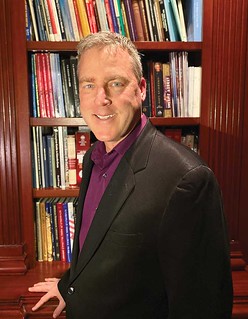 Circulated specimens are relatively affordable, though many have been cleaned or bear damage and therefore it's increasingly difficult to find these types of coins in PCGS holders regardless of grade. Classic gold coins are conditional rarities in the better grades, as they are among certain die marriages. The sheer elusiveness of this historic gold coinage has long been a draw for Daryl Haynor, noted expert and author of United States Classic Gold Coins of 1834-1839.
Circulated specimens are relatively affordable, though many have been cleaned or bear damage and therefore it's increasingly difficult to find these types of coins in PCGS holders regardless of grade. Classic gold coins are conditional rarities in the better grades, as they are among certain die marriages. The sheer elusiveness of this historic gold coinage has long been a draw for Daryl Haynor, noted expert and author of United States Classic Gold Coins of 1834-1839.
As a collector, I have always steered into unchartered waters, and the classic gold series is the neglected stepchild in the family of United States gold coins that never garnered the respect it deserved. I wrote the book, in part, because I wanted to change that perception.
His exceptional collection of classic gold will be showcased as a separate catalog in Stack's Bowers Galleries' August Showcase Auction. The sale is certain to shine a light on these short-lived but dynamic series, which offer tremendous opportunities and challenges for the intrepid collector. Haynor hopes that his book, which was recently awarded the Numismatic Literary Guild Book of the Year award, will attract collectors into the new frontier of classic gold die marriages. However, collectors will also learn that gem-quality classic gold coins are far rarer than previously imagined.
To read the complete article, see:
Coins of the Issue: Classic Gold Quarter Eagle & Half Eagle Rarities
(https://www.pcgs.com/news/coins-of-the-issue-classic-gold-quarter-eagle)
 To read earlier E-Sylum articles, see:
To read earlier E-Sylum articles, see:
NEW BOOK: U.S. CLASSIC GOLD COINS OF 1834-1839s
(https://www.coinbooks.org/v23/esylum_v23n12a02.html)
BOOK REVIEW: U.S. CLASSIC GOLD COINS OF 1834-1839
(https://www.coinbooks.org/v23/esylum_v23n26a07.html)
BOOK REVIEW: U.S. CLASSIC GOLD COINS OF 1834-1839
(https://www.coinbooks.org/v23/esylum_v23n28a04.html)
NUMISMATIC NUGGETS: JUNE 26, 2022
Here's a selection of interesting or unusual items I came across in the marketplace this week. Tell us what you think of some of these. -Editor
Pre Civil War 1859 token Miller / Rulau Ma Bo 77 UNC Details with light hairlines from cleaning. Jos. H. Merriam Die Sinker 18 Brattle Square Boston Medals Struck In Gold, Silver, Copper Or Tin. Thomas Sayers Champion Of England 1859 (125-150).
Super Merriam diesinker business card from Steve Hayden's eBay listings. -Editor
To read the complete lot description, see:
1859 Boston Massachusetts Merchant Token Merriam Die Sinker Sayers Boxing Champ
(https://www.ebay.com/itm/384953635971)
5th US Colored Troops Civil War Soldiers ID Dog Tag. James Joel Co. H. 5th U.S. Colored Vol's. Union Co. O. Maj. Gen. G.B. McClellan Peninsular Campaign.
We are pleased to offer the third and final group of Civil War ID tags and Corps badges from the Rich Burnham collection. This last group were his absolute favorites and will be sold over the next few months on eBay. Many different types are presented including rare, unusual and historically significant items. Rich was an avid collector and researcher of these fascinating items for over 35 years. He found his first disc while metal detecting at a 2nd Corps camp in Rockville, Maryland. His first actual purchase (first of many) was from the late dealer Steve Tanenbaum. He really enjoyed doing the research on the soldiers and units, and each item purchased will come with his research file folder.
Another great item from Steve Hayden's eBay listings. -Editor
To read the complete lot description, see:
5th US Colored Troops Civil War Soldier ID Dog Tag Union County Ohio
(https://www.ebay.com/itm/203996446325)
A neat display item for bank note collectors. -Editor
To read the complete lot description, see:
Lot 44: Antique Bank Note Cigar Five Cents Tin
(https://www.invaluable.com/auction-lot/antique-bank-note-cigar-five-cents-tin-44-c-849458e853)
WAYNE'S NUMISMATIC DIARY: JUNE 26, 2022
Tuesday June 21, 2022 was my first day back at the office following five days at home for our daughter's high school graduation festivities and a long holiday weekend. I was tired, but looking forward to the monthly dinner meeting of my Northern Virginia numismatic social group, Nummis Nova.
Our host for the evening was Jon Radel and he'd made a reservation at the Greek restaurant Nostos in Vienna/Tyson's Corner. Parking was getting tight but I found a spot and made my way to our table. I took a seat between Jon and Daryl Haynor. The remaining attendees were Mike Packard, Dave Schenkman, Eric Schena, Robert Hoppensteadt, Steve Bishop, Roger Burdette, and Julian Liedman.
For the first time in ages I'd brought nothing to display - zero, zip, nada. No new books or other recent acquisitions, and I hadn't been working on my collection or library. But my fellow members came through as always and some of their displays are discussed below. But first, some of my posed and cameo group photos.
Topics of conversation at my end of the table included upcoming sales - for Daryl the upcoming Stack's Bowers Galleries sale of his classic half eagle gold variety collection, and for me a small consignment of foreign material to Stephen Album. Jon told us of the travails of a postal shipment from Poland, Dave filled us in on former regular Gene Brandenburg, and all of us indulged in non-numismatic topics running the gamut from vacation trips to researching family history. Roger passed around a copy of his new article on "Circulation of Foreign Gold and Silver Coins in the United States – 1826", based on U.S. Mint survey records found in the National Archives.
Steve's Beauties
Steve Bishop had a nicely toned 1881 Morgan dollar and an interesting overstruck 1762 Russian 4 Kopeck piece that Daryl and I discussed.
The Akropolis of Gangra-Germanicopolis
Robert Hoppensteadt collects Roman coins with images of architecture. He brought this recent purchase from the Leu Numismatik auction 11, lot 190.
APHLAGONIA. Gangra-Germanicopolis. Caracalla, 198-217. Tetrassarion (Orichalcum, 30 mm, 15.46 g, 6 h). AYT•K•M•AYP• ANTONINOC Laureate and cuirassed bust of Caracalla to right, seen from behind. Rev. GANGPON• // APX• / ?AF• View of the akropolis of Gangra-Germanicopolis, with two smaller buildings, with pointed roofs, between two large towers; all buildings with entrances; between the left tower and the left building, masonry; the smaller building on the right seen in half-perspective. Bricault & Delrieux - (D42/R106). Price & Trell -, cf. fig. 517 (same reverse die, but with bust to left). Very rare and very likely the finest known. A beautifully struck example with an exceptional architectural reverse. Very minor smoothing on the reverse, otherwise, nearly extremely fine.
From a European collection, formed before 2005.
Buried beneath the modern Turkish town of Çankiri, nothing has survived of Gangra-Germanicopolis to the present day and hence, we hence not know what the ancient city looked like, except for the unusual architectural images appearing on very rare Roman Provincial issues struck under Caracalla. Given the two towers on the left and right and the masonry emerging from the left tower, it seems likely that this is a rendering of the city walls, or more specifically, of the local akropolis. That Gangra-Germanicopolis was fortified follows from Strabo, who reports that the Galatian dynast Deiotaros '... possessed Gangra, the royal residence of Morzeüs, which was at the same time a small town and a fortress.' (Strab. XII, 3.41).
It is worth noting that this is the only issue of Gangra to omit its Roman name, Germanicopolis, leading Bricault & Delrieux to speculate that the depiction of the local, presumably very old akropolis and the focus on the city's native name may represent a deliberate accentuation of Gangra's antiquity, thus underlining the rather unsubtle epithet APX ?AF (= APXEOTATH ?AF?AGONIAS), meaning 'the oldest (city) of Paphlagonia'.
McKinley Political Badge
Dave Schenkman brought a very unusual political item.
Dave writes:
"This is the most unusual political item I've encountered, and I have to wonder why they were produced; wearing one would be really uncomfortable. The medal is a brass shell, five inches in diameter, and overall length is nearly seven inches. In addition to the political message, the manufacturer, James Murdock, Jr., a Cincinnati die-sinker has displayed his name prominently on the cardboard reverse. Murdock produced several different varieties of the badge, and also a couple featuring a bust of Admiral George Dewey."
Dave's Dollars
While Dave is known far and wide as The Token Guy®, he often surprises us with a wide variety of numismatic items, from gorgeous British coronation medals to U.S. type coins. Tonight he brought along three slabbed early U.S. dollars dated 1795, 1796, and 1799. He photographed this one for us.
Nice coin!
THE BOOK BAZARRE
NUMISMATIC COMMEMORATIONS OF PRIDE
Nathan Elkins published an article on the American Numismatic Society Pocket Change blog on numismatic commemorations of Pride. -Editor
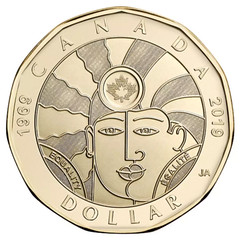 Numismatic commemorations of Pride and the challenges historically experienced by LGBTQIA+ community are, however, remarkably lacking. In fact, the first (and only) circulating coin to recognize the tribulations of the LGBTQIA+ community and its advances towards equality was struck in Canada in 2019. The one-dollar coin, sometimes referred to as the
Numismatic commemorations of Pride and the challenges historically experienced by LGBTQIA+ community are, however, remarkably lacking. In fact, the first (and only) circulating coin to recognize the tribulations of the LGBTQIA+ community and its advances towards equality was struck in Canada in 2019. The one-dollar coin, sometimes referred to as the gay loonie,
depicts two intertwined faces and the phrases EQUALITY and ÉGALITÉ. While the Royal Canadian Mint sold colorized variations and proofs of this coin directly to collectors, three million were struck for general circulation. The coins marked 50 years since Canada's partial decriminalization of homosexuality and referred to the LGBTQ2 movement; in Canada the 2
in LGBTQ2 refers to the two-spirit concept among native peoples, of having both masculine and feminine qualities, which some indigenous people in Canada have deployed as a means of describing their own gender identities. While many welcomed the gay loonie,
it was also criticized by some as suggesting that the work for LGBTQIA+ equality is complete; some conservative religious groups were offended that the LGBTQIA+ community was recognized on official currency.
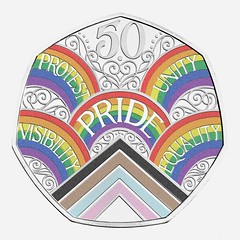 In May 2022, it was announced that the UK's Royal Mint was releasing a 50p Pride coin, marking 50 years since the UK's first pride protest in London in 1972 (Fig. 3). The colorized coin features four rainbows with the words PROTEST, UNITY, VISIBILITY, and EQUALITY superimposed on them, surrounding a fifth central rainbow with the word PRIDE on it. While the rainbows exhibit colors from the original gay-pride flag adopted in 1978, the lower element of the coin displays four chevrons of black, brown, light blue, and pink, which derive from the more recent progress-pride flag that directly recognizes people of color and the transgender community (on the forms of the pride flag, see here). Unlike the Canadian dollar that entered circulation in 2019 (and that to my knowledge remains the only circulating coin with such content), the new design on the UK's 50p coins is only available by direct sales and will not enter circulation.
In May 2022, it was announced that the UK's Royal Mint was releasing a 50p Pride coin, marking 50 years since the UK's first pride protest in London in 1972 (Fig. 3). The colorized coin features four rainbows with the words PROTEST, UNITY, VISIBILITY, and EQUALITY superimposed on them, surrounding a fifth central rainbow with the word PRIDE on it. While the rainbows exhibit colors from the original gay-pride flag adopted in 1978, the lower element of the coin displays four chevrons of black, brown, light blue, and pink, which derive from the more recent progress-pride flag that directly recognizes people of color and the transgender community (on the forms of the pride flag, see here). Unlike the Canadian dollar that entered circulation in 2019 (and that to my knowledge remains the only circulating coin with such content), the new design on the UK's 50p coins is only available by direct sales and will not enter circulation.
While the challenges and accomplishments of the LGBTQIA+ community generally remain unmarked on the circulating coinage of Europe and North America, and LGBTQIA+ people still endeavor for social equality and legal rights and protections, there should be no doubt as to their economic impact (pink money
) and broader contributions to society and culture. In Chicago in the 1980s, when a city ordinance guaranteeing equal rights for the gay community failed, the local gay community began stamping paper money with Gay $
in red to communicate their economic presence and power, despite the fact that many would have preferred them to remain quiet and invisible. The collection of the Coin Room of the Ashmolean Museum, which also provides a helpful summary, contains similar objects pertaining to historical LGBTQIA+ activism through the marking of paper currency, including a rubber stamp used to mark bills with the phrase QUEER CASH and a U.S. fifty-dollar bill stamped Lesbian Money
in purple on its reverse.
The stamping of paper currency is not just a relic of activism of the 1980s and 1990s, but continues to this day. The most recent and noteworthy examples are the stamps of Harriet Tubman's face that Americans are placing on circulating twenty-dollar bills over Andrew Jackson's face (Fig. 5) after a plan to replace Jackson with Tubman as part of a new design by 2020 was scrapped by the new federal administration after the 2016 election.
To read the complete article, see:
The LGBTQIA+ Community and Numismatic (In)visibility
(https://numismatics.org/pocketchange/lgbtqia/)
To read the earlier E-Sylum article, see:
ROYAL MINT'S RAINBOW 50P PRIDE COIN
(https://www.coinbooks.org/v25/esylum_v25n23a28.html)
EAST INDIA COMPANY GODDESS HERA GOLD COIN
The East India Company commissioned coin designer Joel Iskowitz to create a series of coins on the Goddesses of Ancient Greek and Norse mythology. Great design! -Editor
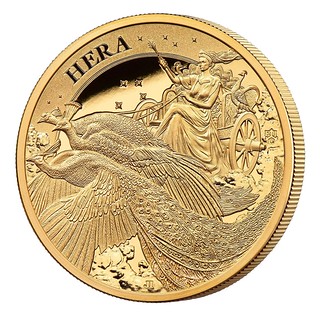 East India Company Collections introduces a new coin series which will tell the stories of the Goddesses of Ancient Greek and Norse mythology.
East India Company Collections introduces a new coin series which will tell the stories of the Goddesses of Ancient Greek and Norse mythology.
Despite originating in ancient myths and legends, Goddesses inform modern life perhaps more than we realize. Their mythology, religious legends, history and folk tales influence movies, TV shows, museum exhibits and famous brands such as cameras and running shoes.
Theirs are stories of intricate family sagas, wars fought by powerful dynasties, love found and lost, the worlds of nature and magic and the realms of gods and men, featuring fantastical creatures and characters who inspire our imaginations and codes of living. Morals, virtues, beliefs and ethics are all integral to the mythology of the Goddesses.
The series starts with Hera, wife and sister of the mighty Zeus, one of the twelve principal deities of the Greek pantheon who lived upon Mount Olympus.
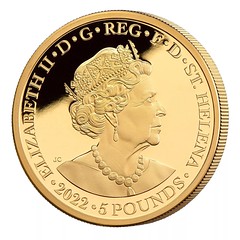
Queen of the Immortals is she, surpassing all in beauty:
she is the sister and wife of loud-thundering Zeus,
the glorious one whom all the blessed throughout high Olympos reverence and honour
even as Zeus who delights in thunder.
- A strictly limited edition of just 100 coins worldwide
- One ounce of gleaming 999.9 fine gold
- Struck to our highest Proof quality finish
- Bespoke presentation case and storytelling booklet
- Exclusive new design by Joel Iskowitz
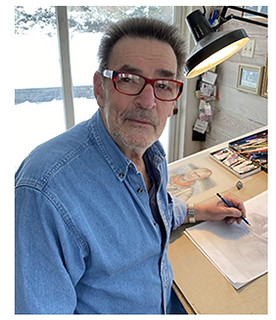 Joel Iskowitz's classical illustrative design depicts Hera riding through the heavens in her grand chariot, pulled along by her sacred peacocks, their tails covered in the hundred ever-watchful eyes of the mighty Argus.
Joel Iskowitz's classical illustrative design depicts Hera riding through the heavens in her grand chariot, pulled along by her sacred peacocks, their tails covered in the hundred ever-watchful eyes of the mighty Argus.
Every fine detail of Joel Iskowitz's intricate design is emphasised by the Proof quality finish of this 1oz Gold coin, presented in a bespoke display case along with a certificate of authenticity which guarantees its accuracy and quality.
To read the complete article, see:
2022 Goddess Hera 1oz Gold Proof
(https://www.theeastindiacompany.com/bullion/2022-goddess-hera-1oz-gold-proof/)
TIFFANY COMMISSION SCRIP
The June 2022 issue of Nena News from the New England Numismatic Association has a nice article by Gary E. Lewis titled "Panic of 1873 In New England." It's about Tiffany commission scrip, produced for New England merchants following the financial Panic of 1873. With permission, we're republishing it here. Many thanks to John Ferreri for assistance. -Editor
The period following the Civil War was a time of expansion and rapid growth for New England. New industries like milling, lumber, fishing, and other enterprises all formed what is now known as the Golden Age.
As most numismatists know, currency in the 1870's and for most of the
nineteenth century was based on specie. Metal money circulated in New
England, and many local state banks issued paper banknotes backed by
the supply of gold and silver. This system changed due to financial demands imposed by the Civil War. President Lincoln authorized the printing of Demand Notes in 1861, called Greenbacks
, to pay the ballooning expenses of the war.
Just twelve years later, the Panic of 1873 became the first global depression brought about by industrial capitalism. Banks raised millions of dollars through selling bonds to finance construction of the westward expansion of the railroad. However, construction expenses ballooned and outpaced financing, thus efforts to raise additional funds failed. While only the first of many market corrections, the effects of the downturn when Jay Cooke & Company closed its doors in September 1873 were severe and unexpected. It began a regular pattern of boom-and-bust cycles that continues to this day in New England.
This 1873 panic effected numerous small businesses throughout the New
England area. During the late 19th and early 20th century, many companies used currency look alikes
to promote their business and certainly
to get people's attention. In addition, because of the severe economic
downturn, New England shop owners preferred receiving cash for purchases and those purchasers who did pay in cash expected to receive a
discount. One of the most known promoters of these advertising notes
were the Tiffany Brothers.
Oscar F Tiffany started his sales promotion of commission scrip in Detroit and later moved to Buffalo where his brother Nelson joined him in the business. The business was located at 265 Washington St, Buffalo NY. Clay Cossack Co and White & Brayley Co., lithographers, printed the scrip in the Buffalo area.
The lithographed Tiffany scrip was normally printed in two formats, a dollar size (6.5 x 3 inches) and a smaller fractional size (3.5 x 2 inches).
The fractional scrip was printed to conform to the government fractional size of the government fractional currency then in general circulation. Most of the Tiffany scrip is printed with black ink on white bank note paper. A few examples of brown ink on white paper exist. Tiffany scrip exists in denominations from ten cents to $50 dollars.
The obverse, or face, of each scrip typically has a one or two beautiful vignettes and the vendors name, line of goods, and address. The reverse, or back, of the scrip typically has a redemption statement like redeem the note for $5 used in conjunction with a cash purchase of $100 or more.
The purpose of the scrip was to encourage the return of customers by offering a discount or commission on the next cash purchase. The scrip was accepted only at the retail establishment named on the scrip. For those of you who collect Tiffany commission scrip, I am sure you find it a challenging task because of the rarity of the scrip. Even though fifty-eight merchants in the New England area utilized the Tiffany scrip as a marketing tool, I believe most scrip is R-7 or higher on the rarity scale.
A long-time friend of mine, Gene Hynds, who spent years studying and collecting Tiffany scrip was able to locate Tiffany scrip issued in the New England states by merchants in Connecticut, Maine, Massachusetts, and Rhode Island. Gene's Connecticut records reflect notes issued in Danbury, Hartford, and New Haven by three different merchants. Furthermore, his Maine records reflect notes issued in Auburn, Augusta, Bangor, Belfast, Gardner, Hallowell, and Lewiston by nineteen merchants. The largest number of Tiffany scrip was issued in the following cities in Massachusetts: Arlington, Belfast, Beverly, Boston, Brighton, Cambridgeport, Fitchburg, Haverhill, Hyde Park, Lowell, Lynn, Natick, Northamp- ton, Palmer, Provincetown, Salem, Somerville, Springfield, Stoneham, Wakefield, Waltham, Ware, Webster, and Worcester by thirty-five merchants. Only one merchant in Providence issued scrip in Rhode Island according to Gene's records.
Collecting numismatic items like Tiffany Scrip can be a fun and enjoyable part of this great hobby we all enjoy.
For more information on the New England Numismatic Association, see:
https://www.nenacoin.org/
BRITAIN'S SWITCH TO POLYMER BANKNOTES
Arthur Shippee passed along this Washington Post article about Britain's switch to polymer banknotes. -Editor
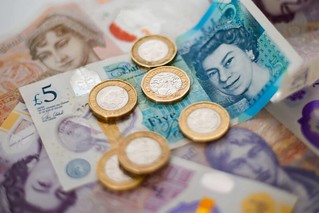 Britain's Central Bank will remove bank notes worth 14.5 billion pounds, or nearly $18 billion, from circulation by Sept. 30, as it seeks to retire its remaining paper currency in favor of polymer bills. The transition will make Britain the world's largest economy that uses only plastic-like bank notes.
Britain's Central Bank will remove bank notes worth 14.5 billion pounds, or nearly $18 billion, from circulation by Sept. 30, as it seeks to retire its remaining paper currency in favor of polymer bills. The transition will make Britain the world's largest economy that uses only plastic-like bank notes.
The Bank of England urged people holding paper 20- and 50-pound bills to spend or deposit them with a financial institution before they are no longer legal tender. Retail outlets will no longer accept them starting in October, but banks and the U.K. Post Office may continue to do so. Britain is one of Europe's most cashless societies, with many consumers switching to digital and card payments during the coronavirus pandemic.
Polymers, known for their flexibility, are an important ingredient in many plastics. The Bank of England said polymer notes tend to be cleaner. They are also water resistant and harder to fake because the laborious manufacturing process is likely to put off counterfeiters.
Australia, which began issuing polymer bills in 1992, was the first economy to switch from paper currency. The U.S. dollar is printed on a linen and cotton blend with red and blue fibers randomly distributed to deter counterfeiting.
Jane Austen, the celebrated writer of romantic novels, is depicted on the polymer 10-pound bills. The 20-pound polymer note bears a portrait of J.M.W. Turner, a 19th-century artist renowned for his landscape and seascape paintings. The new 50-pound bill showcases Alan Turing, a founding father of computer science and artificial intelligence who was a code breaker during World War II. The story of his life was adapted into the Oscar-winning film The Imitation Game.
The notes going out of circulation feature Adam Smith, a Scottish economist who wrote a seminal text on capitalism, and the industrialist-inventors Matthew Boulton and James Watt.
To read the complete article, see:
Britain to pull $18B in bank notes as it switches from paper to polymer
(https://www.washingtonpost.com/world/2022/06/24/uk-banknotes-paper-polymer/)
FEDERAL RESERVE NOTE GOLD BACKING
Wayne Pearson submitted these notes on the redeemability of Federal Reserve Notes in gold. Thanks. -Editor
Once upon a time, in 1929, Federal Reserve Notes (1928 series) were backed by gold. In this $5 example, read what it says on the upper left.
Now look at a 1934 $5 FRN. After FDR outlawed gold, you can see the difference in the writing.
For more background on Federal Reserve Notes, Wayne passed along this Investopedia article. Thanks. -Editor
Federal Reserve notes were first issued after the creation of the Federal Reserve System (FRS) in 1913. Before 1971, any Federal Reserve note issued was theoretically backed by a legally specified amount of gold held by the U.S. Treasury, though since 1933 private citizens were not allowed to actually redeem them for gold dollars. Because these notes held legal tender status and represented actual dollars (legally specified as a given quantity of gold held by the Treasury), they came to commonly be referred to as "dollar bills" as they circulated through the economy.
However, under President Nixon, the last vestige of the gold standard was officially abandoned, creating a fully fiat currency, where the Federal Reserve notes themselves became the sole circulating legal tender (along with small base-metal coins), redeemable only for other Federal Reserve notes and not for physical dollars.
Federal Reserve notes are not backed by hard assets. Instead, Federal Reserve notes are now backed solely by the government's declaration that such paper money was legal tender in the United States, or by fiat.
Today, Federal Reserve notes circulate as money throughout the U.S. and the rest of the world wherever dollar-denominated transactions take place. These notes are still commonly referred to as "dollars," which was previously a legally defined quantity of gold or silver but is now simply the official unit of account for U.S. legal tender, including Federal Reserve notes.
The U.S. Treasury prints the Federal Reserve notes at the instruction of the Board of Governors and the twelve Federal Reserve member banks. These banks also act as the clearinghouse for local banks that need to increase or reduce their supply of cash on hand. Once new Federal Reserve notes are issued, they become a liability of the Federal Reserve, which can be redeemed by bearers on demand for different Federal Reserve notes.
To read the complete article, see:
Federal Reserve Note
(https://www.investopedia.com/terms/f/federal-reserve-note.asp)
THE WAL-MART COIN-COVERED CADILLAC
Greg Burrus of Chattanooga writes:
"I saw this Cadillac on Reddit the other day and found a few other sites with details about it. I wanted to send it along as it might be of possible interest (that is, if it's not been shared already). Thanks for a great newsletter!"
I don't believe we've discussed this one before - thanks! -Editor
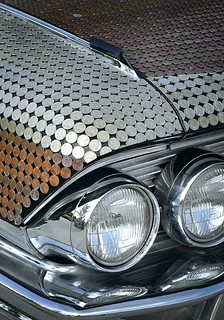 "It's not something you see every day, obviously," Ben Breen of Bentonville said after his ride in a new permanent art installation at 21c Museum Hotel in Bentonville. "It's really cool. I've never ridden around in a car that old!"
"It's not something you see every day, obviously," Ben Breen of Bentonville said after his ride in a new permanent art installation at 21c Museum Hotel in Bentonville. "It's really cool. I've never ridden around in a car that old!"
Breen, 13, his mother and younger bother were among the first visitors on June 19 to take a complimentary ride around the downtown square in the completely refurbished 1962 Fleetwood Cadillac limousine -- which also happens to be covered in about 30,000 pennies, nickels and dimes.
Artist Monica Mahoney of Louisville, Ky., was commissioned to create an art car for 21c in Bentonville after designing two for the original hotel in Louisville a few years ago.
"We really enjoyed having the experience of the art cars available to the guests," Alice Stites, chief curator of 21c Museum Hotels, says of the cars at their Louisville location. "It was natural to commission Monica again."
In development since the hotel opened in 2013, the new art car was finally finished in May and put on display in front of the museum in early June.
"I anticipated about six months for the coins, and I was on time with that, but the car took a really long time," Mahoney says. "The car was in really bad shape when the owner of 21c found it on eBay, so there was a lot of waiting while they searched for parts and even built parts for the car. They had to replace almost everything."
When the finished product rolled into Bentonville last month, the plush black and rust-colored interior leather and fluffy black carpeting all looked brand new. The exterior also got a makeover, with nearly 600 pounds worth of coins covering the car in lines and designs. Mahoney says her inspiration for using coins came from Sam Walton's Five & Dime Store.
"When I was researching the history of Bentonville, I just found so much about Wal-Mart and how it started as the five-and-dime," Mahoney says. "And I really like art cars with texture, so I thought, 'Oh, I'll use nickels and dimes to cover the car.' And so with the art piece, I was really exploring the relativity of value and how little value we see in a penny, but how [Wal-Mart] 'shaves pennies' off the cost of everything, and that's what's really making the difference."
Mahoney says she likes the idea that everyone will see something different in the art. Some people will look at the coins, which add up to roughly $950, and say, "This looks like a lot of money," while others look at the same car and say, "This doesn't seem like that much at all."
To form straight lines on the car and keep them even, Mahoney had to cut, bend and sand coins. She also devoted a lot of time to separating the shiny pennies from the medium shiny from the tarnished ones, in order to create the patterns she envisioned. Most of the pennies Mahoney used were 1962 uncirculated pennies, but she says there are also other interesting finds on the car.
"I kind of hid some cool things on the car -- steel pennies, Indian-head nickels, really old coins -- anything interesting I came across during the process," Mahoney says. "I hope people enjoy exploring it and it makes them smile, because maybe each time they look at it, they see something different."
To read the complete article, see:
It All Adds Up
‘Making Change' a tribute to Walton's fiscal savvy
(https://www.arkansasonline.com/news/2015/jul/10/it-all-adds-up-20150710/)
Greg forwarded a number of articles. Here are some additional photos. -Editor
To read the complete articles, see:
Making Change
1962 Cadillac Limo clad in coins from 1962
(https://www.reddit.com/r/WeirdWheels/comments/v6dy7t/
making_change_1962_cadillac_limo_clad_in_coins/)
The Story Behind The Coin Covered 1962 Fleetwood Cadillac
(https://www.masoncapitalgroup.com/the-story-behind-the-coin-covered-1962-fleetwood-cadillac)
Making Change
(https://www.21cmuseumhotels.com/museum/exhibit/making-change/)

